Nearly everyone we know is obsessed with Seoul and South Korea. Some are into the cosmetics. Many are hooked on the music and television dramas. And almost everyone, including us, is in love with the food.
South Korean technology and pop culture has exploded into the global mainstream in recent years. This “Korean Wave” has turned Seoul into one of the hottest destinations in Asia, bringing in over 17.5 million international tourists in 2019.
Unfortunately, the travel slowdown has brought this tourism wave to a halt, but expect it to surge with a vengeance when borders open up. Until then, you can plan your future trip with the latest edition of our Seoul travel guide.
Read about the best things to do, the coolest neighborhoods to visit, and the tastiest dishes to eat to get you even more excited about visiting the land of kimchee, K-pop, and Korean cosmetics!
VISIT SEOUL QUICK LINKS
This travel guide to Seoul is long. For your convenience, I’ve compiled links to hotels, tours, and other services here.
HOTELS
Top-rated hotels in Myeongdong, the best area to stay for first-time visitors to Seoul.
TOURS
OTHER SERVICES
Save This on Pinterest!
No time to read this Seoul travel guide now? Click on the save button and pin it for later!

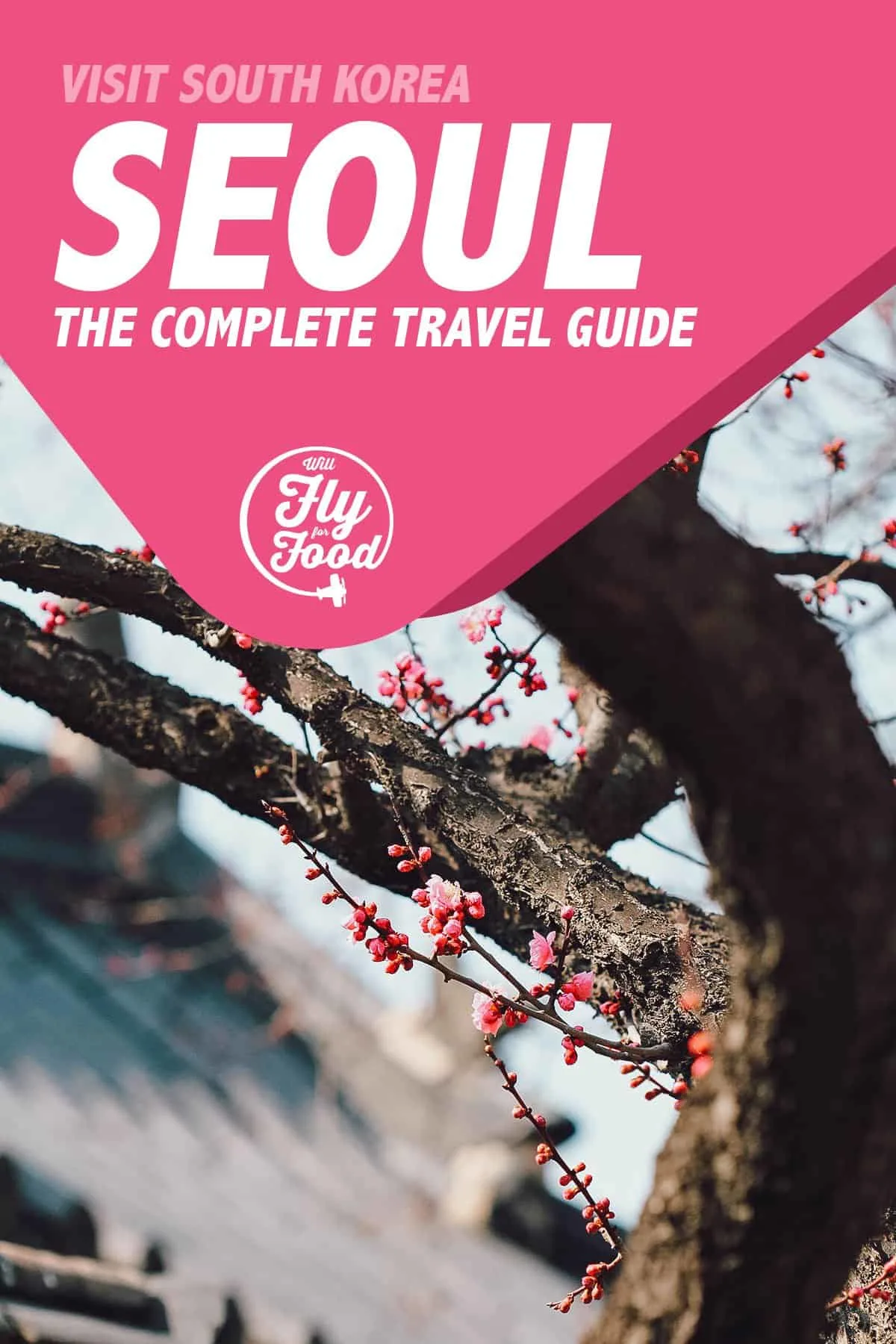
GUIDE TABLE OF CONTENTS
SEOUL TRAVEL RESTRICTIONS
Because of the current global situation, Seoul travel guidelines seem to change on a daily basis. Our friends at Booking.com created a website that lists detailed information on travel restrictions around the globe.
Before planning a trip to Seoul, be sure to check Booking.com for information on travel restrictions to South Korea. If you do decide to visit Seoul, then you may want to seriously consider getting travel insurance with COVID coverage.
SOUTH KOREA VISA
You may need a visa and other travel documents to visit South Korea depending on your passport. Check out iVisa.com to learn about the requirements and to apply for a visa (if necessary).
If you’re a Philippine passport holder living in Manila, then check out our guide on how to apply for a South Korea visa for a step-by-step process.
SEOUL AT A GLANCE
Seoul is the capital of South Korea (Republic of Korea) and its biggest city. The estimated population within its city limits is 10.29 million people, but factor in its surrounding areas and that number jumps to 25.6 million, making it the second largest metropolitan area in the world.
With a workforce that large driving its economy, it’s no wonder Seoul is now the 4th most economically powerful city, behind only Tokyo, New York City, and Los Angeles (as measured by GDP).
South Korea has been making headlines in recent years in the tech, automotive, and entertainment sectors. Korean brands like Samsung and Hyundai are globally recognized brands.
People worldwide watch K-dramas and listen to K-pop. Myeongdong has become a hotbed for cosmetics and nearly everyone I know loves Korean food! Needless to say, South Korea is booming, and at the center of all that excitement, is Seoul.
BEST TIME TO VISIT SEOUL
Like Japan, South Korea has four distinct seasons — Spring, Summer, Fall, and Winter. The most popular times to visit Seoul are during the spring (March-May) and autumn (Mid-September – Early November) months when the weather is ideal and the landscape is at its most striking.
Both seasons are characterized by a dramatic change in color – Spring for its cherry blossom pinks and whites, and Autumn for its fiery reds, oranges, and yellows. Here’s what you can expect during every season.
MAR-MAY: Spring is one of the best times to visit Seoul. The weather is ideal and the city erupts with flowers. If you want to catch the cherry blossoms, then you should plan on being in Seoul around the second week of April (around April 9-10). That will give you the best chance to see the cherry blossoms. With that said, keep in mind that the blossoms are largely dependent on the weather so it’s still no guarantee they’ll be blooming then, which is why I think it’s a good idea to go around that time or a little earlier. If they aren’t blooming yet in Seoul, then you’ll have the option of taking a day trip to Jinhae, home of Korea’s biggest cherry blossom festival. Be sure to bookmark the Visit Korea website for updates on the festival.
JUN-AUG: Summer isn’t an ideal time to visit Seoul. It’s hot, it’s humid, it rains a lot, and prices are at their highest with summertime being the peak of domestic tourism. Avoid these months if you can.
SEPT-NOV: Unless you’re chasing after the cherry blossoms, then the fall is arguably the best time to visit Seoul. Like spring, the weather is ideal and the foliage is at its most striking. Shoot for late October or early November if you can.
DEC-FEB: If you want to go skiing, snowboarding, or just experience snow, then winter is obviously the time to go. However, winter in Korea is freezing. We went in early November and we were surprised by how cold it already was. If you can stand the cold, then there are several ski resorts you can visit from Seoul.
Climate: Annual Monthly Weather in Seoul
Check out weather-and-climate.com for more on the weather in Seoul. For your convenience, I’ve also created the average temperature and annual rainfall graphs below. Suggested months to visit are highlighted in orange.
Average Temperature
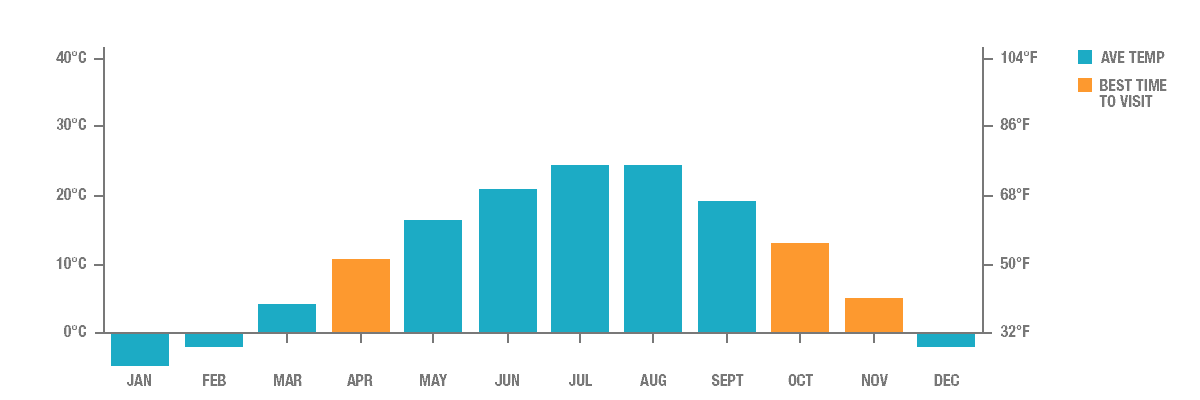
Annual Rainfall
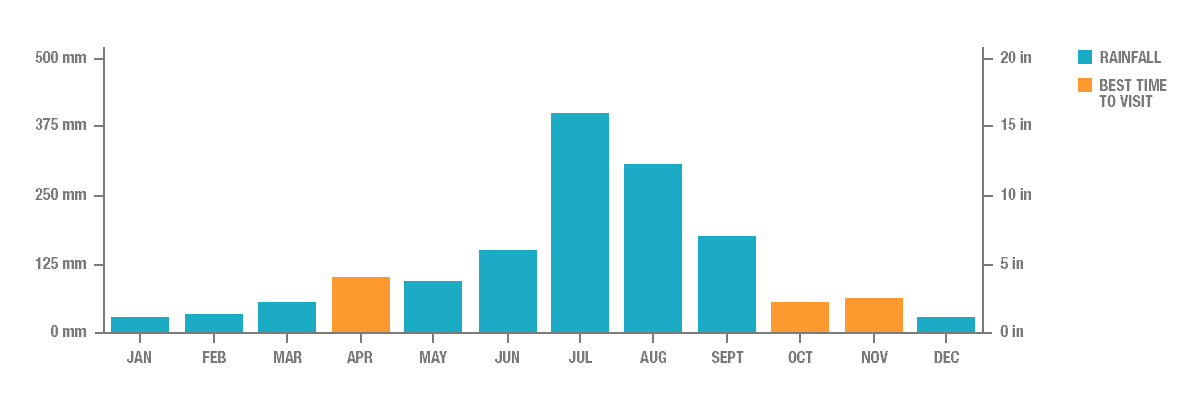
TRAVELING TO SEOUL
There are many different ways you can travel to Seoul depending on where you are. You can check Bookaway or use the widget below to find route options available to you.
Almost all international flights land at Incheon International Airport. There are several ways to get to downtown Seoul from Incheon. You can refer to this website for more information on airport transfers.
BY AIRPORT EXPRESS (AREX): This is the fastest way to get to the city from the airport. It runs like clockwork and it’ll get you into Seoul Station in exactly 43 minutes. The trains are comfortable with free wifi onboard. You can purchase tickets at the gate (KRW 9,500) but you can get a discount if you get them in advance through Klook.
BY ALL-STOP TRAIN: This is the second-fastest way to get into Seoul from Incheon. It’ll get you to Seoul Station in about 58 minutes and costs around half the price of the AREX (KRW 4,150-4,750). Trains run from 5:23AM till 11:40PM. This is the train we usually take.
BY BUS: A one-way bus ticket costs KRW 5,000-15,000 and takes longer than the subway (around 80 minutes), so I suggest taking it only if you’re arriving at Incheon during off hours. Late night airport buses to Seoul Station run from 12MN-4:40AM, while buses to Gangnam Express Bus Terminal operate from 11:40PM-4:20AM. Detailed inquiries on bus routes and bus stops can be made at the Airport Information Desk on the 1st floor. Click on the link for more information on late night airport buses.
BY TAXI: Going by taxi is convenient but also expensive. A taxi will get you into the city in about an hour and will cost you anywhere between KRW 65,000-90,000.
BY PRIVATE TRANSFER: This is the best and most convenient option but also more expensive. Click on the links to book private airport transfers through Klook or Get Your Guide.
Check out the Visit Korea website for more information on airport transfers.
WHERE TO EXCHANGE CURRENCY
The unit of currency in Seoul is the Korean Won (KRW).
Myeongdong is the best place to exchange your currency. There are plenty of money changers in the area and they’re known to give the best rates in the city. We scoped out a few other areas and the rates were never as good.
I suggest changing a small amount at the airport, no more than USD 100, just to get you into the city. You can then change the rest in Myeongdong.
A better option these days is to withdraw KRW from an ATM. The rates are competitive, sometimes even better. Just be sure to let your bank know that you’ll be using your ATM card abroad so you don’t run into any problems. In my experience, my ATM card works in some machines but not in others. I didn’t have any problems using it in Seoul.
TIP: Some ATM machines may ask you if you’d like to proceed “with or without conversion”. Always choose WITHOUT conversion. Proceeding “with conversion” allows the foreign bank operating the ATM to perform the conversion at rates favorable to them. According to this article, the difference in rates can be as high as 10{0b5b04b8d3ad800b67772b3dcc20e35ebfd293e6e83c1a657928cfb52b561f97}.
BEST AREAS TO STAY IN SEOUL
Based on our own experiences and what I’ve read online, Myeongdong, Insadong, Hongdae, and Itaewon are the best places to stay in Seoul. They offer different things so it all depends on what you want.
Myeongdong is ideal for shopping, Insadong for culture and the arts. Hongdae is young and hip while Itaewon is Seoul’s international district. We’ve visited all four areas but we’ve only stayed in Myeongdong and Hongdae. Personally, we prefer Hongdae.
I’ll go through each area in more detail below but you can search for hotels in Seoul on Booking.com and Agoda.
To make it easier, I’ve created the color-coded map below so you can see where all these recommended areas are. Click on the link for a live version of the map. (Please note that marked areas are approximations only)
RED – Myeongdong
ORANGE – Hongdae
PURPLE – Insadong
AQUA – Itaewon
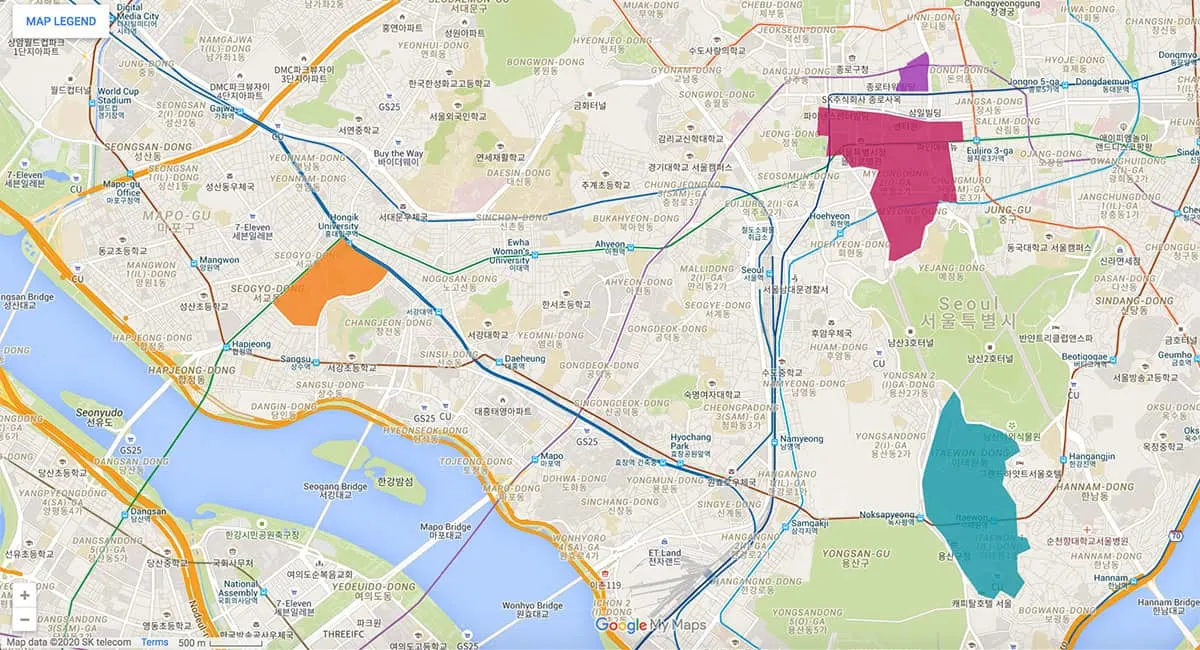
MYEONGDONG
If you’re planning on doing a lot of shopping in Seoul, then Myeongdong is definitely where you need to stay. It’s a hyper shopping district filled with big name brands and boutique shops, as well as many restaurants, cafes, and street food stalls. If you like Korean cosmetics, then there’s a good chance you’re never leaving this place.
The place we stayed at doesn’t seem to be available anymore but you can search through Booking.com and Agoda for hotels in Myeongdong. Check out some of the top-rated hotels in the area:
INSADONG
We haven’t stayed in Insadong but we’ve spent many days exploring its wealth of traditional shops, boutiques, restaurants, cafes, and teahouses. It’s also walking distance to several key attractions like Gyeongbokgung Palace, Changdeokgung Palace, and Bukchon Hanok Village.
You can search through Booking.com and Agoda for accommodation listings in Insadong. Check out some of the top-rated hotels in the area:
HONGDAE
Ren and I aren’t into shopping so we preferred staying in Hongdae. It refers to the area around Hongik University. It’s a fun and youthful area with an easygoing college town vibe. This was our favorite neighborhood in the city so we’ll probably stay here on every return trip to Seoul.
Bingo House is a small 5-room guesthouse just a short walk from Exit 6 of Hongik University Station. There’s a 7-Eleven and a GS25 convenience store nearby, as well as a few restaurants and cafes. There’s a common area with free water and kitchen supplies but no breakfast. You can book a room here through Agoda.
If you like Hongdae but don’t think Bingo House is the right place for you, then you can check these sites for alternate listings: Booking.com | Agoda. Here are a few of the top-rated hotels in Hongdae:
ITAEWON
Among these four areas, Itaewon is the place we’re least familiar with. It’s one of the city’s most diverse neighborhoods boasting plenty of shops and international restaurants. It has a bustling nightlife as well which is one of the reasons why it’s a popular hotspot among expats. You can search through Booking.com and Agoda for accommodation listings in Itaewon. Here are a few top-rated hotels in the area:
You can also book hotels and home stays in Seoul using the handy map below.
PLACES TO VISIT IN SEOUL
1. The Five Grand Palaces
There are five Joseon Royal Palaces in Seoul – Gyeongbokgung, Changdeokgung, Changgyeonggung, Gyeonghuigung, and Deoksugung. We visited only the first two but you can easily visit all five if you like.
Gyeongbokgung and Changdeokgung are the biggest and arguably the most beautiful of the five. Gyeongbokgung was the primary palace and one of just two (the other being Deoksugung) where you can watch the changing of the Royal Guard. Equally impressive is Changdeokgung which is a UNESCO Heritage Site and home to the Huwon or “Secret Garden”.
Check out my article on Changdeokgung and Gyeongbokgung palaces for more pictures and information. You can visit on your own or go on a guided tour (Klook | Get Your Guide). Changdeokgung and Gyeongbokgungare among the most popular places in Seoul to rent a hanbok.
If you plan on visiting multiple palaces on your own, then you may want to invest in an Integrated Palace Ticket.
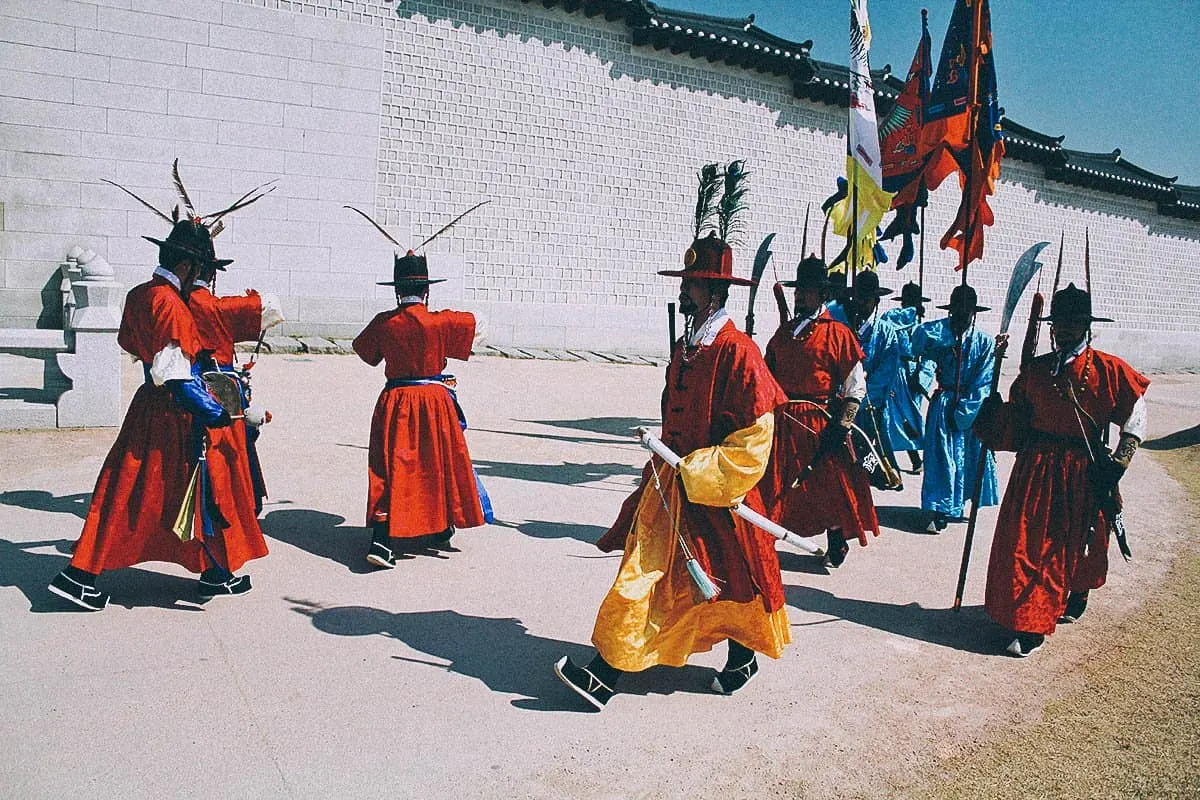
Suggested Length of Visit: 1-3 hrs per palace
Admission: KRW 1,000-3,000 per palace
2. Bukchon Hanok Village
As ultramodern a metropolis as Seoul is, it’s nice to find a place like this right in the middle of the city. Bukchon Hanok Village is an atmospheric labyrinth of narrow alleyways and traditional Korean houses called hanoks.
Exploring its network of streets will take you back in time and give you a glimpse of what Seoul was like 600 years ago. Like the royal palaces, it’s one of the best places in Seoul to rent a hanbok and level up your Instagram game.
Check out my article on Bukchon Hanok Village for more pictures and information. If you’d like to learn more about Bukchon Hanok Village, then you may be interested in joining this free walking tour or going with a guide.
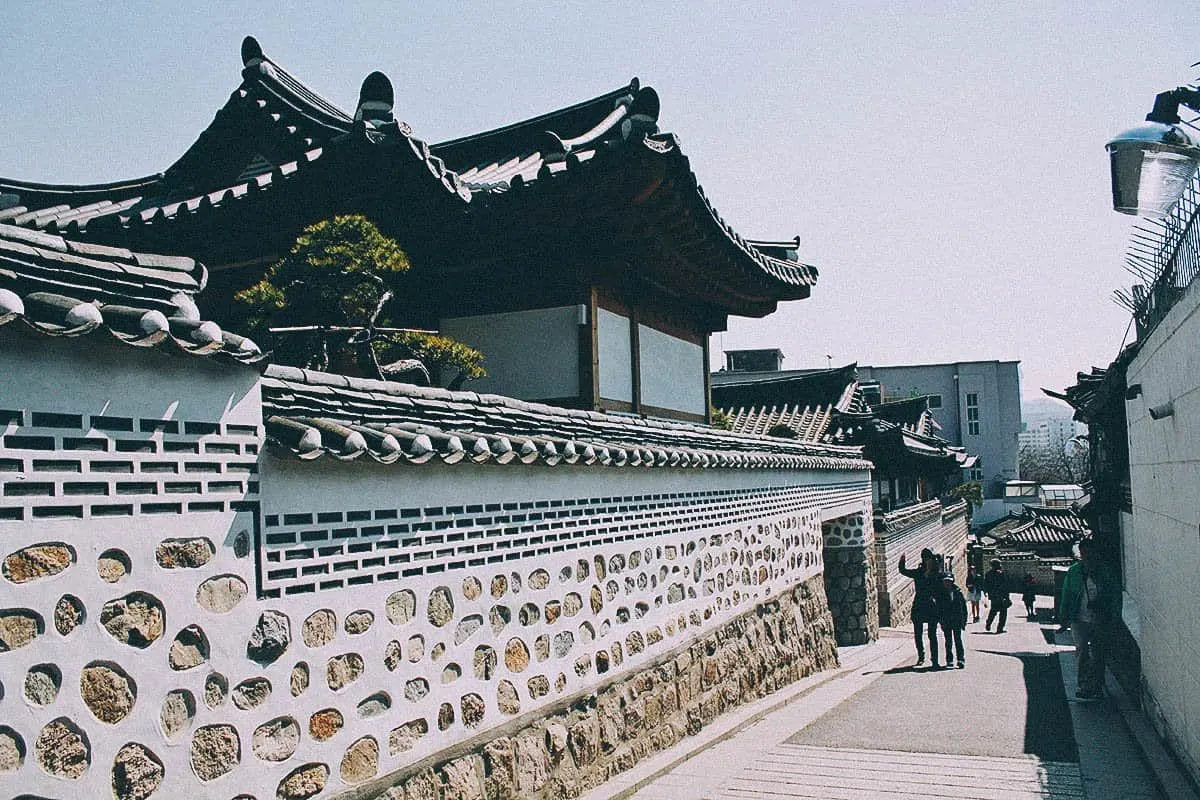
Suggested Length of Visit: 1-2 hrs
Admission: FREE
3. N Seoul Tower
When it comes to great views, this place towers above the competition. Standing 480 meters (1,575 ft) above sea level, N Seoul Tower’s observation deck is the best place to get bird’s eye views of the city.
N Seoul Tower is located on Mt. Namsan and accessible via road or cable car, though most tourists will opt for the latter. You can purchase tickets to the observatory at the gate.
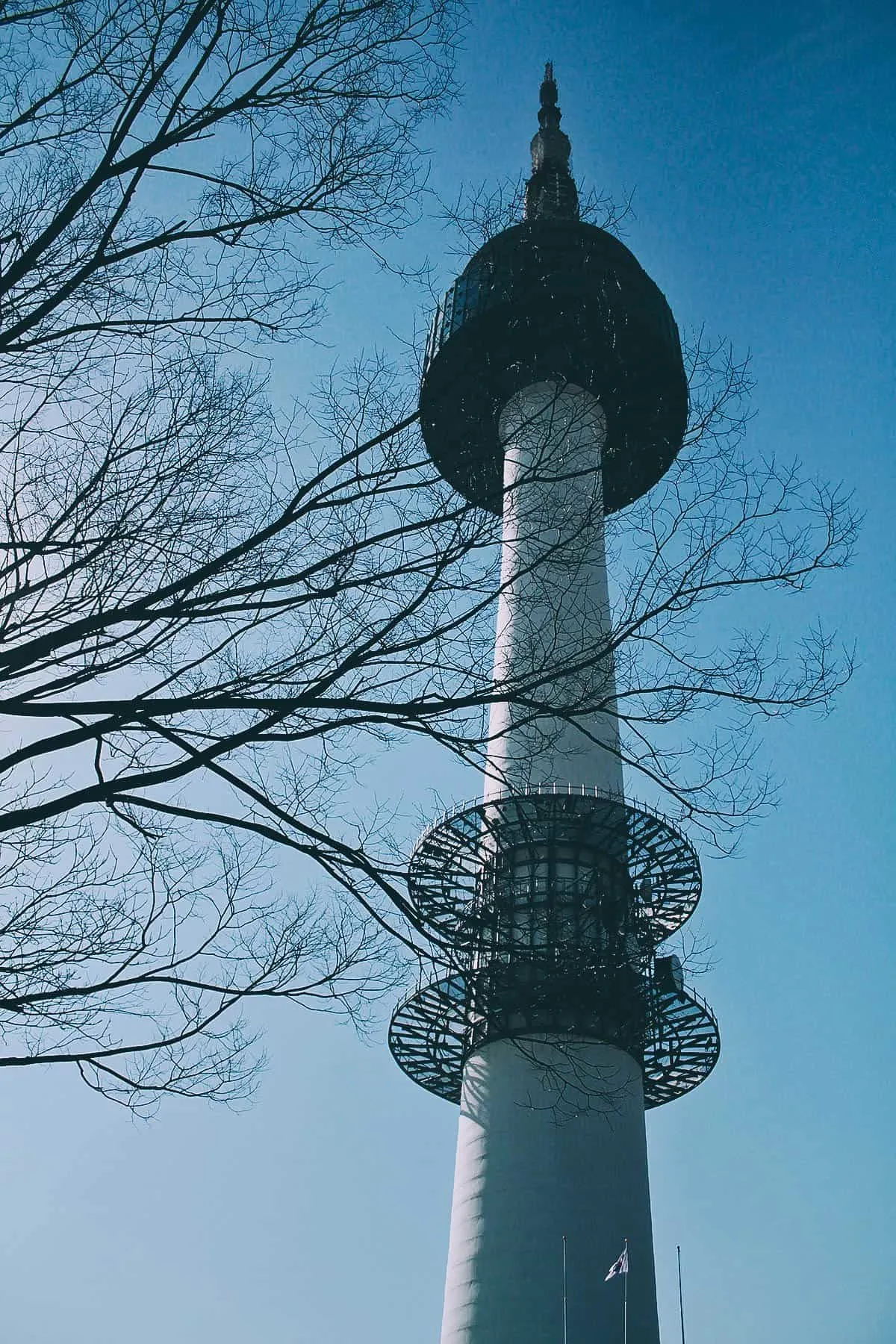
Suggested Length of Visit: 1-2 hrs
Admission: KRW 16,000
4. Dongdaemun Design Plaza (DDP)
This place is incredible. If you like design, any kind of design, then you need to put Dongdaemun Design Plaza (DDP) on your itinerary. It’s like a museum, design supermarket, and space ship all rolled into one.
DDP was designed by the late Zaha Hadid, the renowned architect who created the 2012 Olympic aquatic centre in London and the Guangzhou Opera House in China.
I suggest devoting several hours to this place if you can. Be sure to come back at night as well when the building really comes to life. Check out my article on Dongdaemun Design Plaza for more pictures and information.
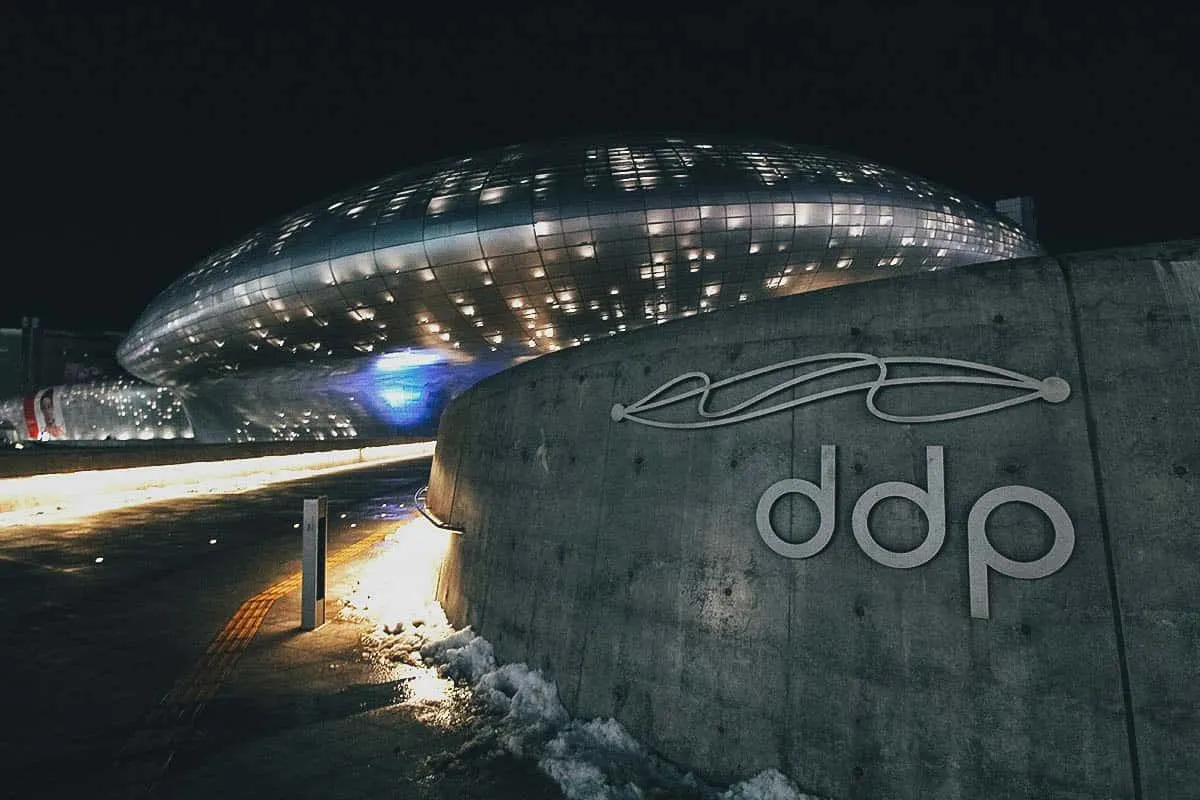
Suggested Length of Visit: 2-3 hrs
Admission: FREE but some exhibits may charge for admission
5. Jogyesa Temple
Jogyesa Temple is one of the most important Buddhist temples in Korea. It’s the head temple of the Jogye Order of Korean Buddhism and serves as the main venue for many Buddhist events, rituals, lectures, and ceremonies.
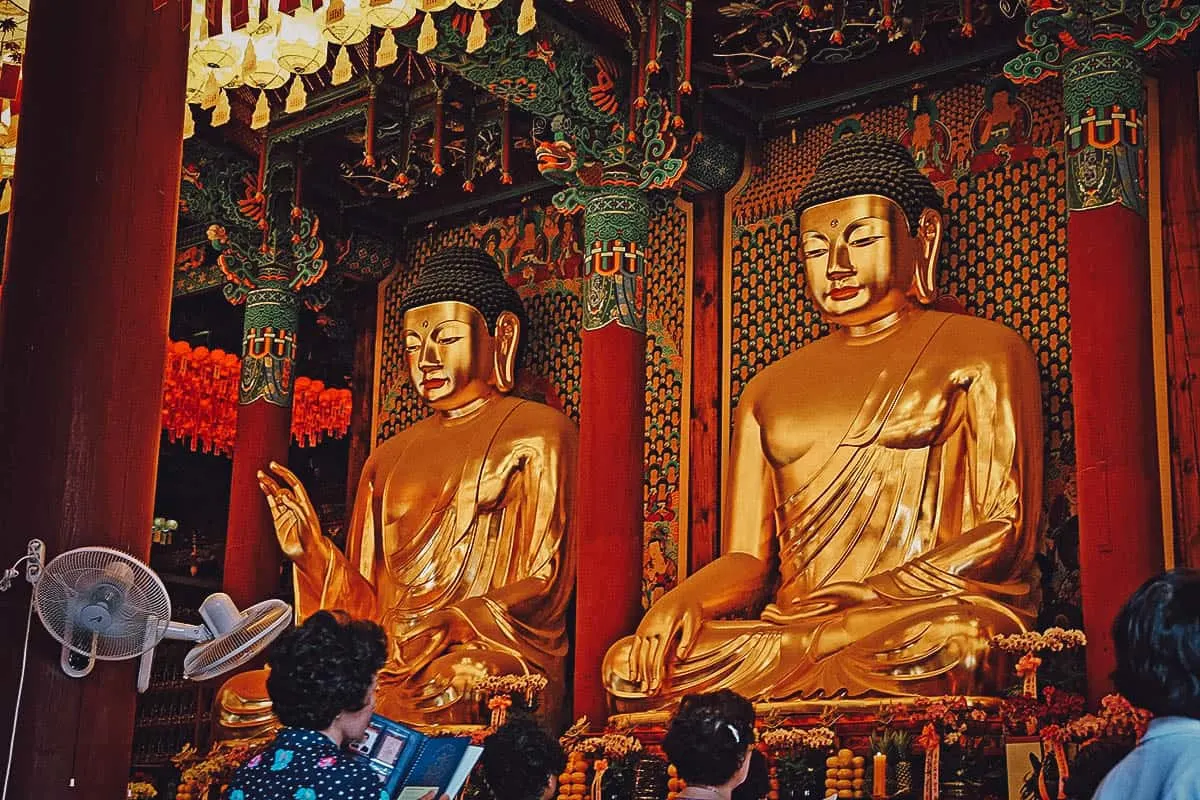
Photo by Various images via Shutterstock
Suggested Length of Visit: 30 mins – 1 hr
Admission: FREE
6. COEX Mall Library
COEX Mall in the Gangnam district has become Insta-famous in recent years, all because of this beautiful library located in the middle of the mall.
Starfield Library is an open-air public library that features hundreds of books and magazines. It’s stunning architectural shelf of books has made it into one of the most popular picture-taking spots in Seoul.
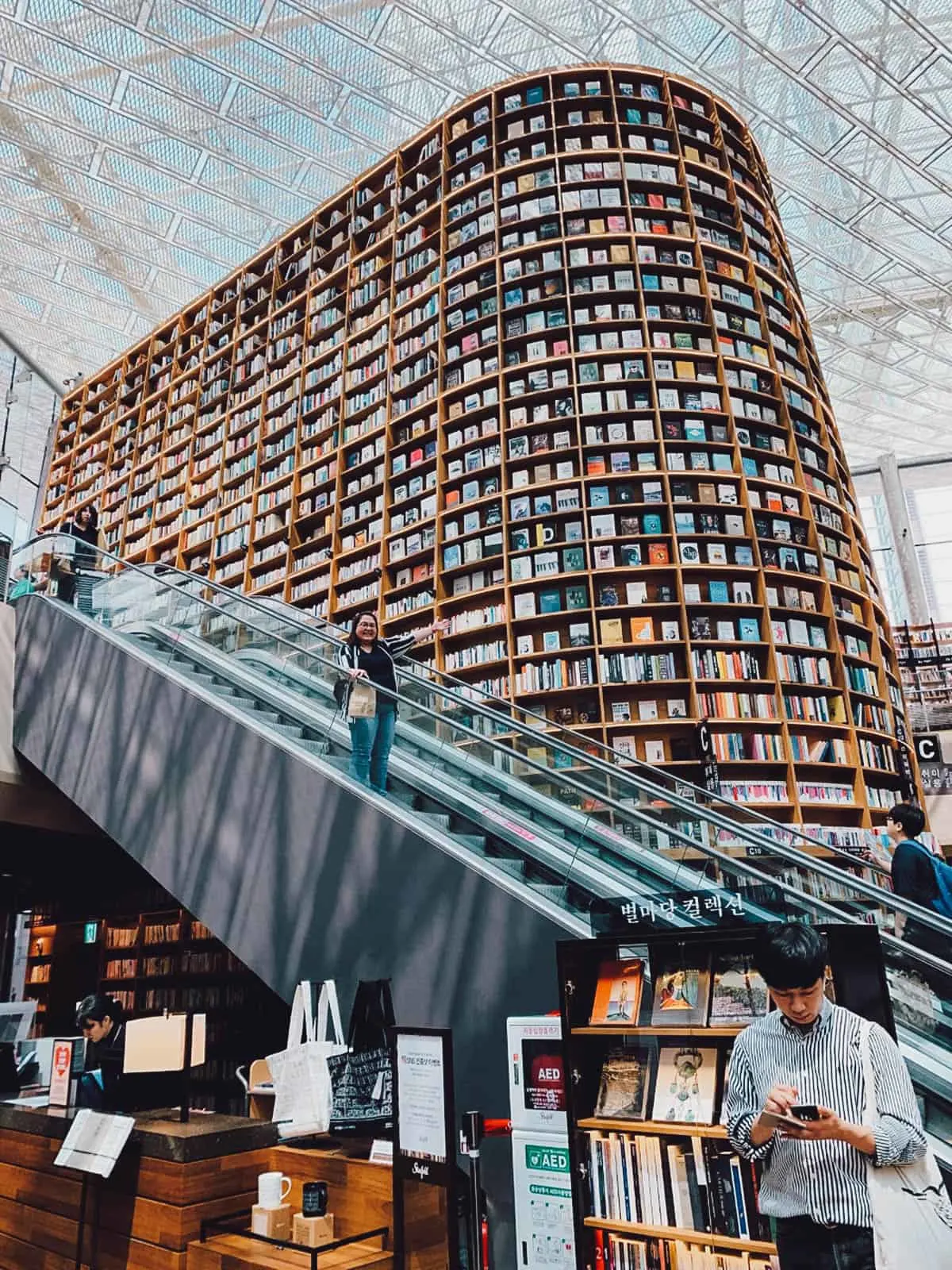
Suggested Length of Visit: 2-3 hrs
Admission: FREE
THINGS TO DO IN SEOUL
1. Dress Up in a Hanbok
If you’re a fan of Korean period dramas or just the culture in general, then you’ll probably want a selfie wearing a hanbok. It’s the traditional Korean form of dress worn by both men and women during festivals and celebrations.
Bukchon Hanok Village and any of the five royal palaces make for great photo backdrops. You’ll find a few hanbok rental shops around those areas but you can also rent one in advance through Klook.
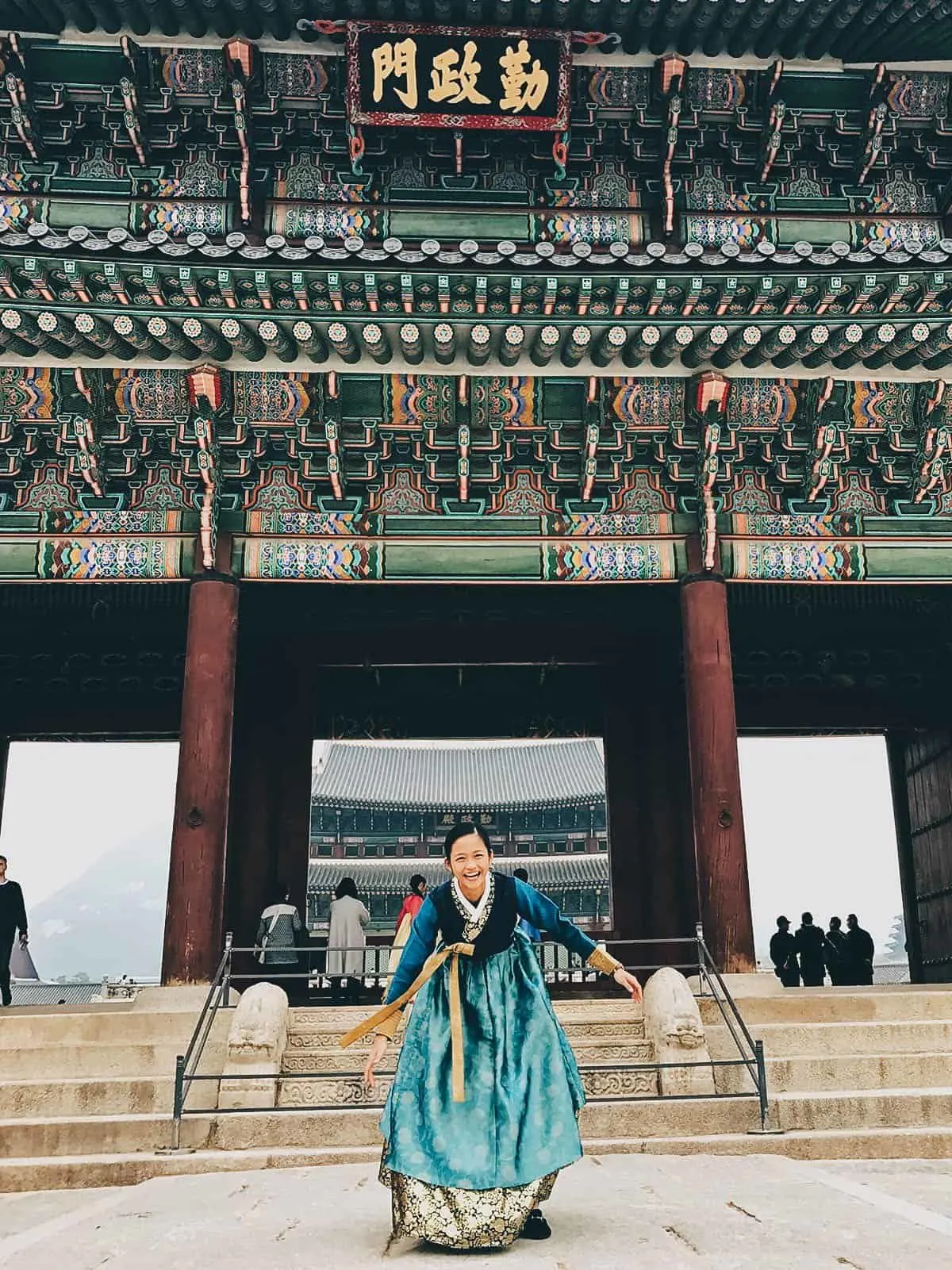
2. Visit a Traditional Korean Market
We love visiting markets on trips because they’re often the best places to find great street food in any city. Seoul is no exception with its many interesting markets like Noryangjin Fish Market, Gwangjang Market (pictured below), and Nandaemun Market. Check them out if you’re looking for cheap and authentic street food in Seoul.
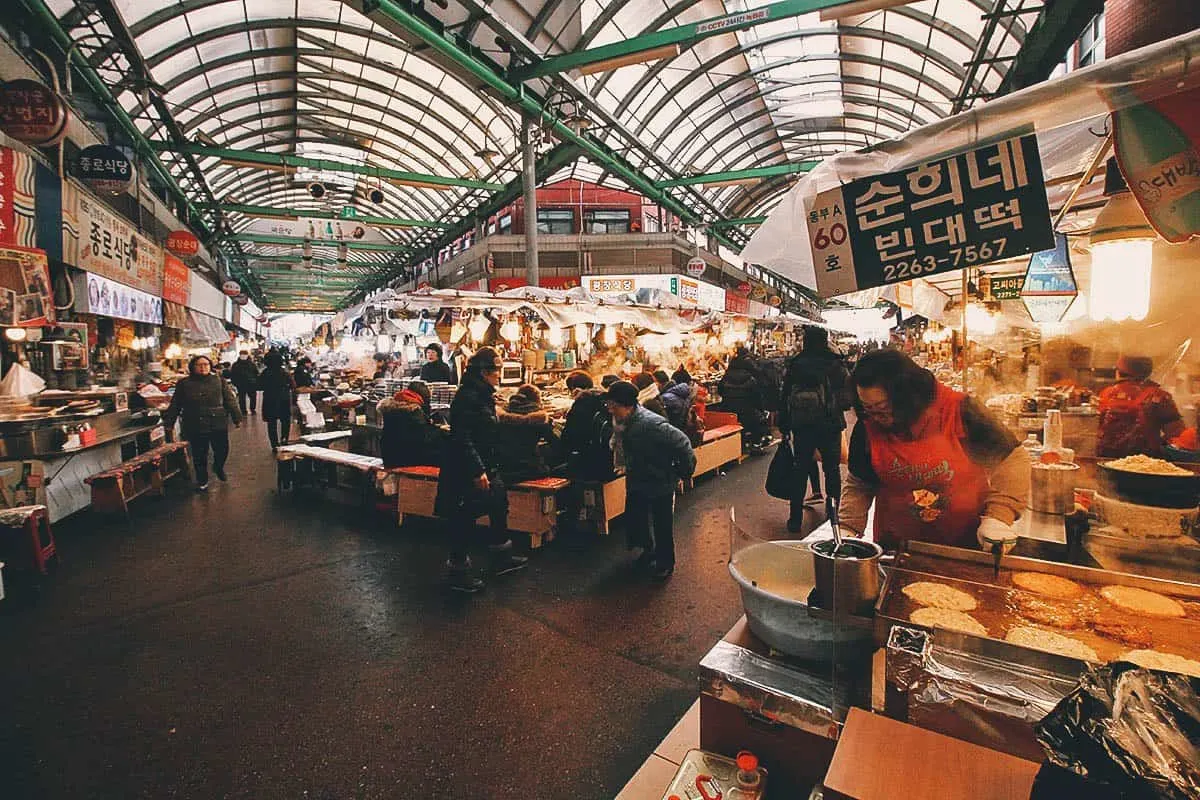
3. Explore Seoul’s Neighborhoods
Seoul is a massive city with many interesting neighborhoods. Four of its most popular include Insadong, Myeongdong, Hongdae, and Itaewon, each with its own distinct personality.
Insadong is known for its traditional arts and crafts, Myeongdong for its brand names and cosmetics, Hongdae for its trendy college town atmosphere, and Itaeown for its international vibe. All have terrific food.
Check out my article on Seoul’s neighborhoods for more pictures and information.
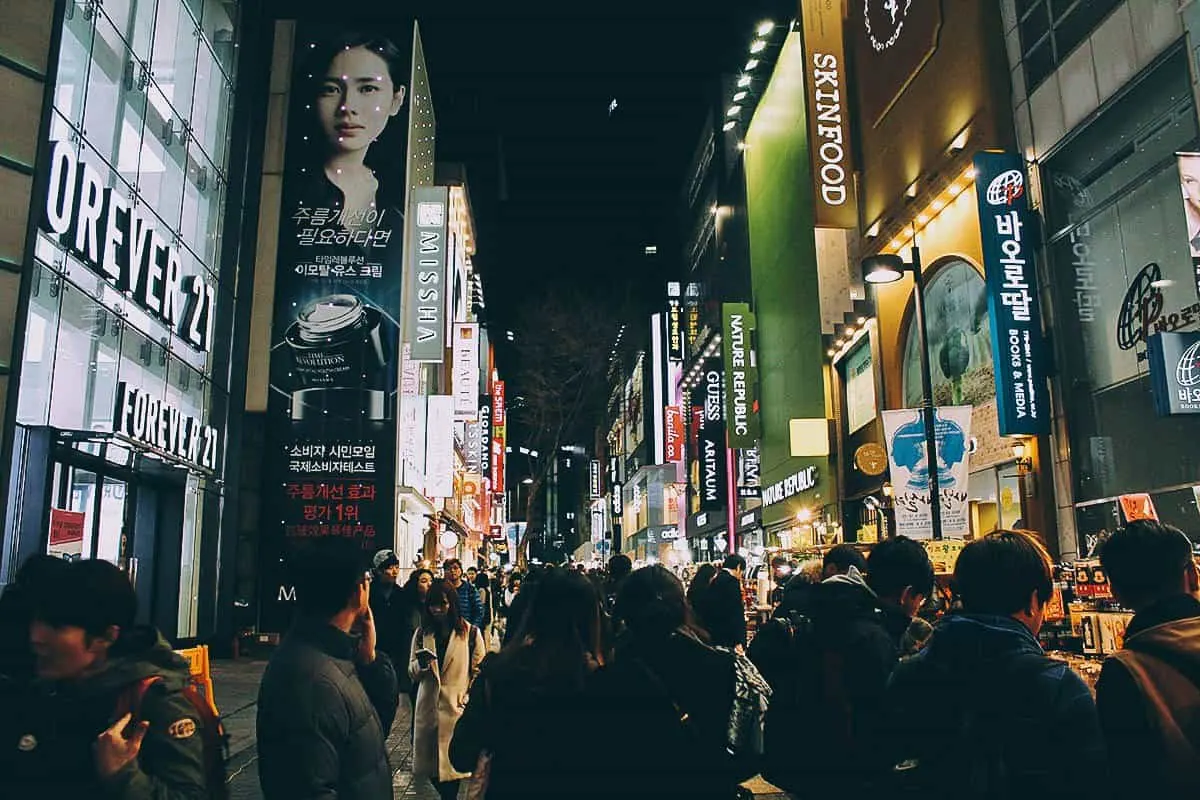
4. Take a Stroll Along Cheonggyecheon Stream
Cheonggyecheon Stream is an 11 km stream that runs through the heart of downtown Seoul. It passes underneath 22 bridges and through a number of city landmarks before opening up into the Han River. It’s a popular picture-taking spot in Seoul and a great place to cool off in the summer.
You can walk along the stream on your own, but if you’d like to learn more about it and the places you’ll be passing along the way, then you may be interested in joining this free walking tour.
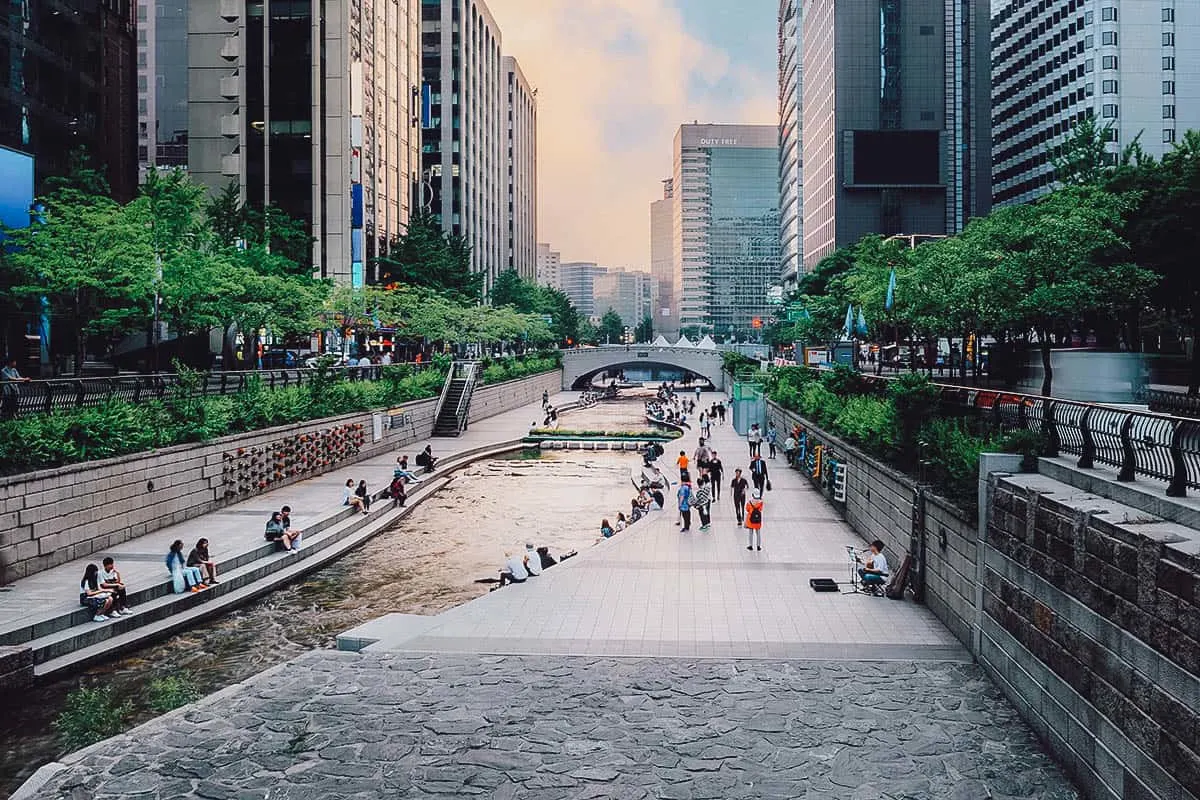
Photo by SS pixels via Shutterstock
5. Go on a K-pop/Kdrama Tour
As described, many people have been turned on to South Korea because of the popularity of Korean pop music and its film and television industry. In fact, we know of a few diehard fans who routinely fly to Seoul just to attend music concerts!
If you have a fascination for Korean pop culture, then you may be interested in booking a K-Pop tour or taking a K-Pop dance class. Aspiring singers can even get a K-Pop recording studio experience!
6. Watch the Cookin’ Nanta Show
If you’d like to watch a show or performance in Seoul, then the Cookin’ Nanta Show is one to consider. It’s entertaining and funny and reminds me of a Korean version of Stomp, but with food.
There are two Nanta theaters – one in Myeongdong and another in Hongdae. You can purchase tickets at the gate but you can sometimes get a discount if you buy them in advance through Klook.
7. Take a Cooking Class
We haven’t done this in Korea but taking a cooking class is something we try to do on every trip. It’s a fun, hands-on way of getting to know the local cuisine.
If you’re interested in taking a cooking class in Seoul, then I suggest searching for one on Cookly. Cookly is an online booking platform that offers cooking classes in many cities around the world, including Seoul.
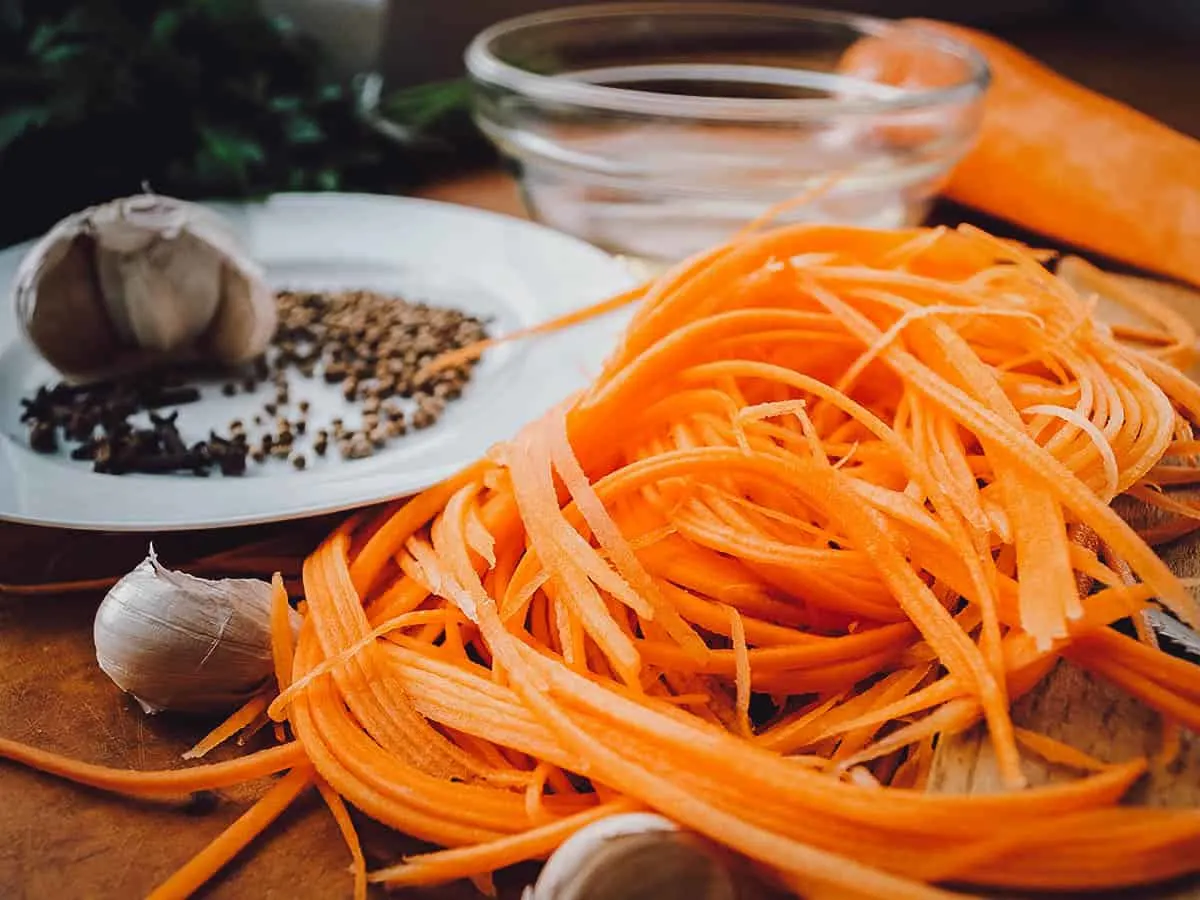
Photo by Smiallaan via Shutterstock
DAY TOURS FROM SEOUL
If you’re staying long enough in Seoul, then you may want to explore beyond the city and go on a day trip. Listed below are four of the most popular but you can check our article on 18 of the best day trips from Seoul for more suggestions.
1. Nami Island
We skipped out on Nami Island on our first trip to Korea because we thought it could only be appreciated by fans of the television drama Winter Sonata. We were wrong.
Nami Island is achingly beautiful and a must-visit for anyone traveling to Seoul. We went in winter when there was a thin sheet of fresh powder blanketing the island. It was beautiful, though perhaps not as magical as the fall when the leaves turn fiery shades of red, orange, and yellow.
You can visit Nami Island on your own but it may be easiest to go on a guided tour (Klook | Get Your Guide). You can refer to my article on Nami Island, Gangchon Rail Park, and Petite France for more pictures and information.
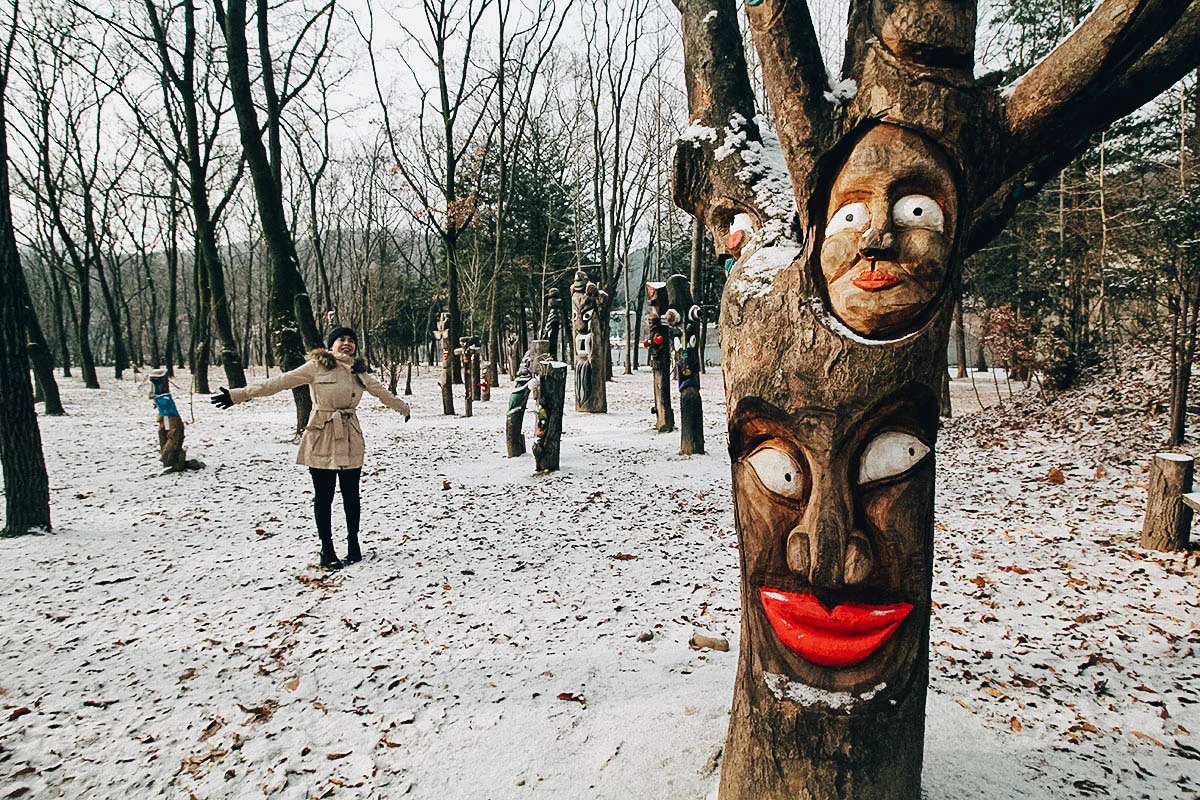
2. The DMZ
This was one of the most interesting tours I’ve ever been on. DMZ stands for Demilitarized Zone and refers to the 4 km wide buffer zone that divides North and South Korea.
When I went, they were still offering visits to the JSA or Joint Security Area. Nicknamed “the most dangerous place in Korea”, it’s the only portion of the DMZ where North and South Korean soldiers can stand face to face. Check out my article on the JSA and DMZ tour for more pictures and information.
I checked and the JSA tour doesn’t seem to be available anymore, perhaps due to the cooling relations between north and south, but you can still book a DMZ tour on Klook or Get Your Guide. It isn’t as intense as the JSA tour but it’s still worth doing, especially if you have an interest in Korean history.
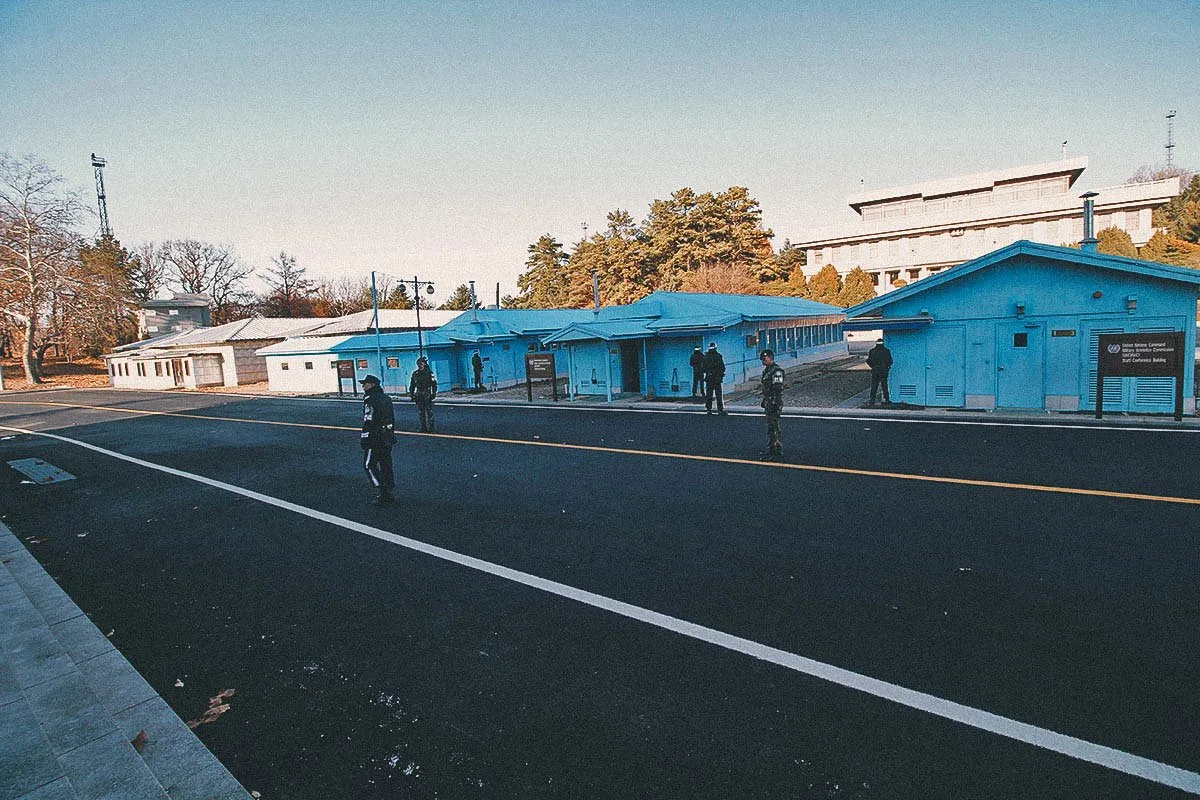
3. Everland Resort
Many tourists, especially those traveling to Seoul with young children, will probably want to visit one (or both) of South Korea’s biggest theme parks – Everland and Lotte World.
Lotte World is located in central Seoul while Everland is about an hour away. We visited Everland and it made for a fun day trip from Seoul. You can check out my article on Everland Resort for more pictures and information.
If you don’t have time to visit both and can’t decide between the two, then you can refer to this Everland or Lotte World comparison post to help you decide. You can purchase a one-day pass to Lotte World or an Everland full day trip with admission and transfers through Klook.
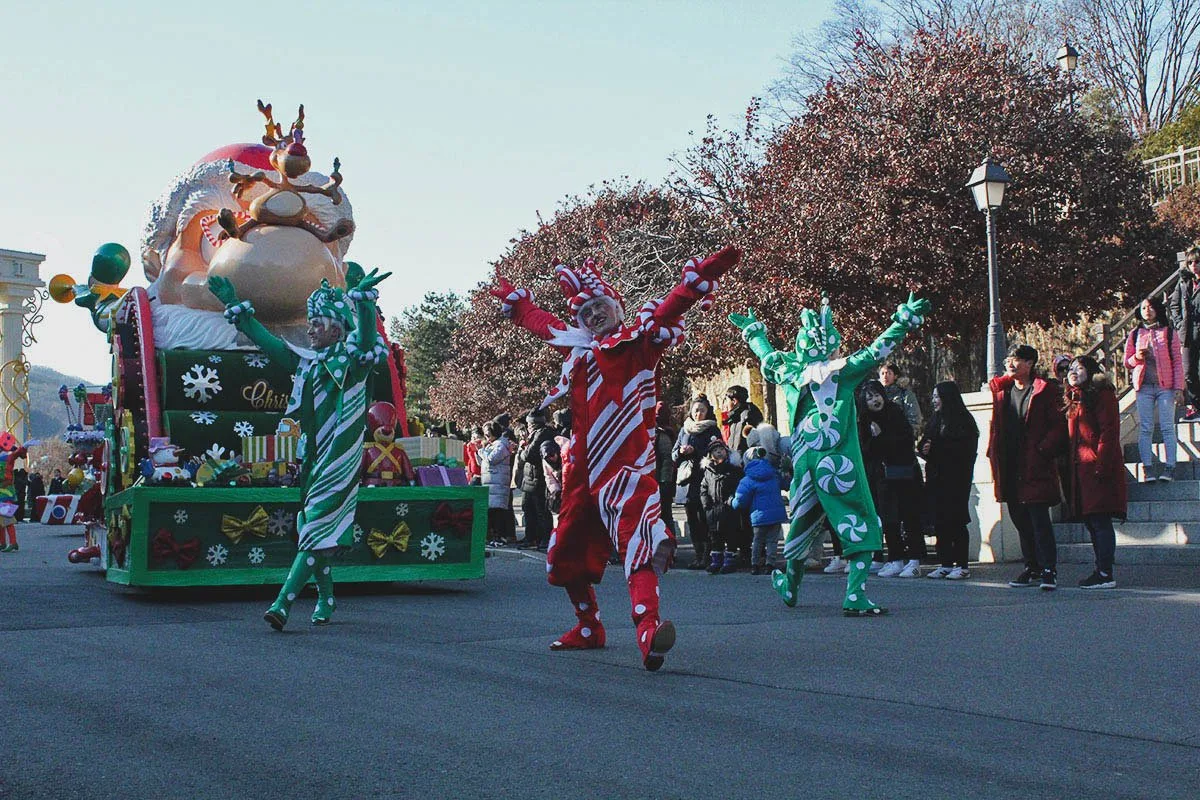
4. Hwaseong Fortress
Hwaseong Fortress is a UNESCO World Heritage Site located about an hour south of Seoul by metro. It’s name means “Brilliant Castle” and it was built in 1796 by King Jeongjo of the Joseon Dynasty to house and honor the remains of his father, Prince Sado.
Hwaseong Fortress offers terrific views of Suwon and is a great place to do some hiking, perhaps even trying your hand in traditional Korean archery. Check out my article on Hwaseong Fortress for more pictures and information.
I visited Hwaseong Fortress on my own but you can also go by guided tour through Klook.
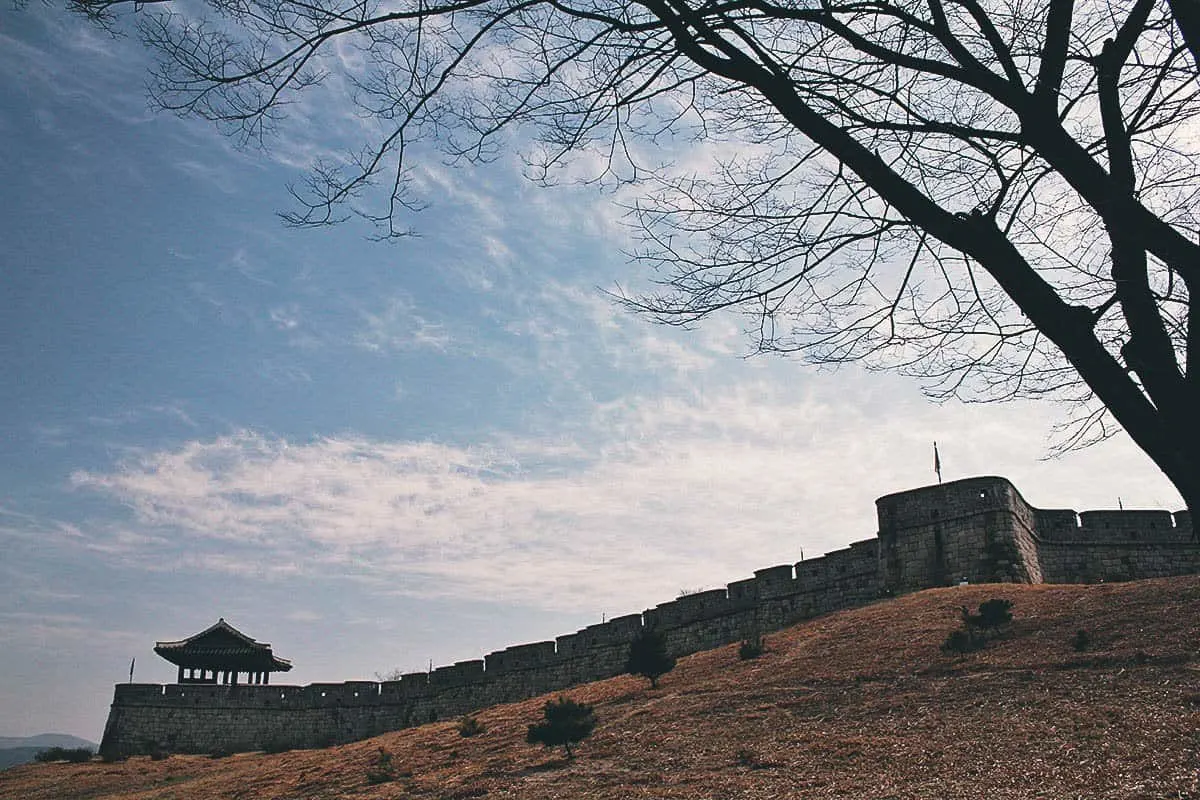
KOREAN FOOD GUIDES
There is so much good food to be had in Seoul. From Korean delicacies like ganjang gejang, galbi, and gomtang to popular street food staples like tteokbokki and gyeranppang, Seoul will have you counting down the minutes to your next meal.
If you’re wondering what to eat in this food lover’s Shangri-La, then you can refer to our article on the best dishes to eat in South Korea. If you have a fondness for street food or sweets, then be sure to check out our Korean street food and Korean dessert guides as well.
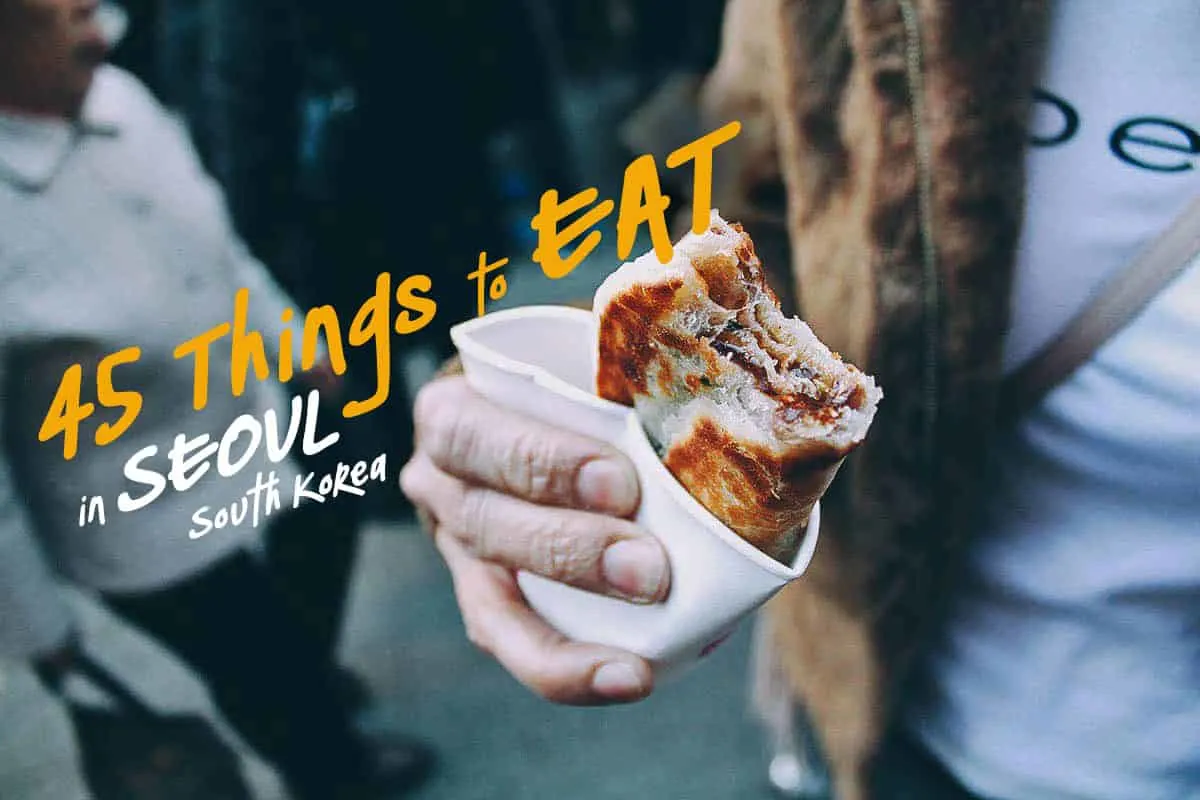
WHERE TO EAT IN SEOUL
1. Yeontabal BBQ Restaurant
Gogigui or Korean BBQ is one of our favorite things about Korean food. Marinated meats like bulgogi and galbi barbecued over a charcoal grill are absolutely delicious.
These grilled king beef ribs at Yeontabal were some of the best we’ve ever had. Smokey, savory-sweet, and super tender, they were to die for, especially when eaten with steamed white rice and kimchi.
Keep in mind that meat is typically expensive in Korea, so expect Korean BBQ to be one of your more expensive meals. You can get a small discount at Yeontabal if you purchase a voucher through Klook.
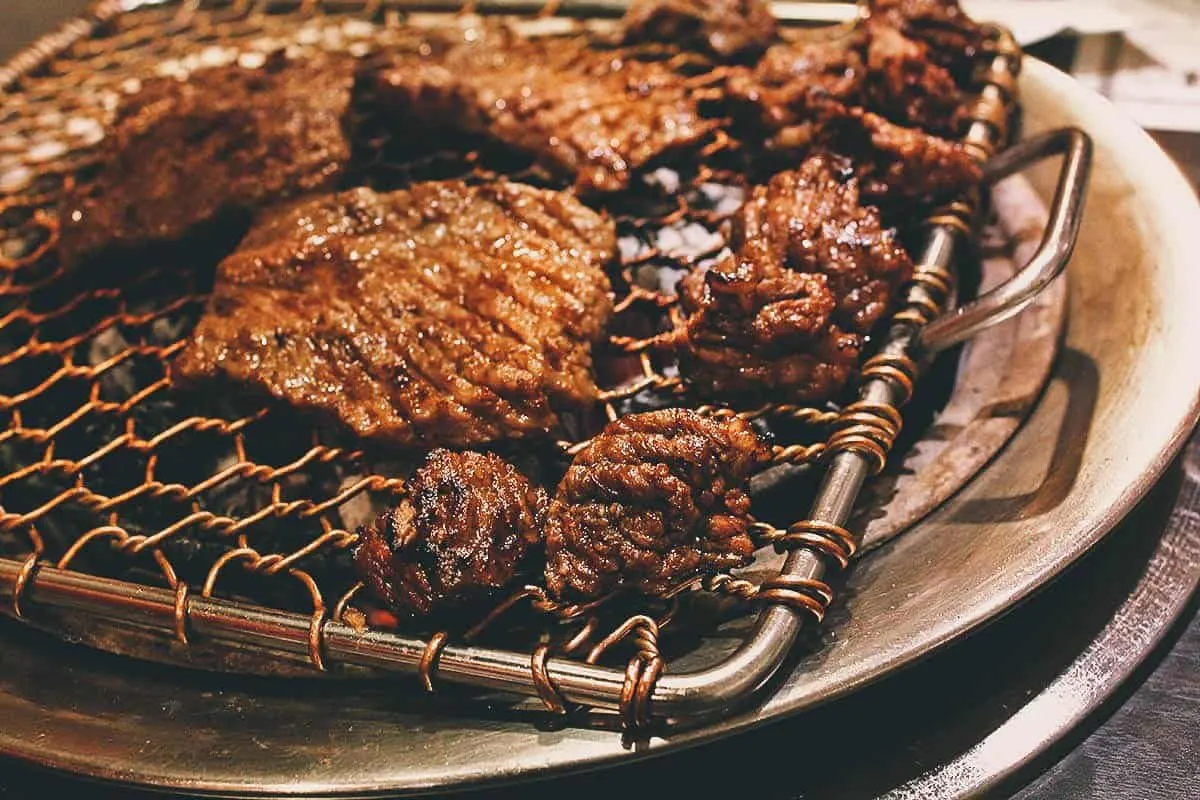
2. Woo Lae Oak
I’ve been wanting to try naengmyeon (buckwheat noodles served in cold broth) ever since I saw a documentary about North Korea. It’s originally a North Korean delicacy that became popular throughout the peninsula after the Korean War.
I searched for the best places to try naengmyeon and Woo Lae Oak, one of Seoul’s oldest restaurants, often came up. They’re a Korean BBQ restaurant that’s equally famous for their naengmyeon.
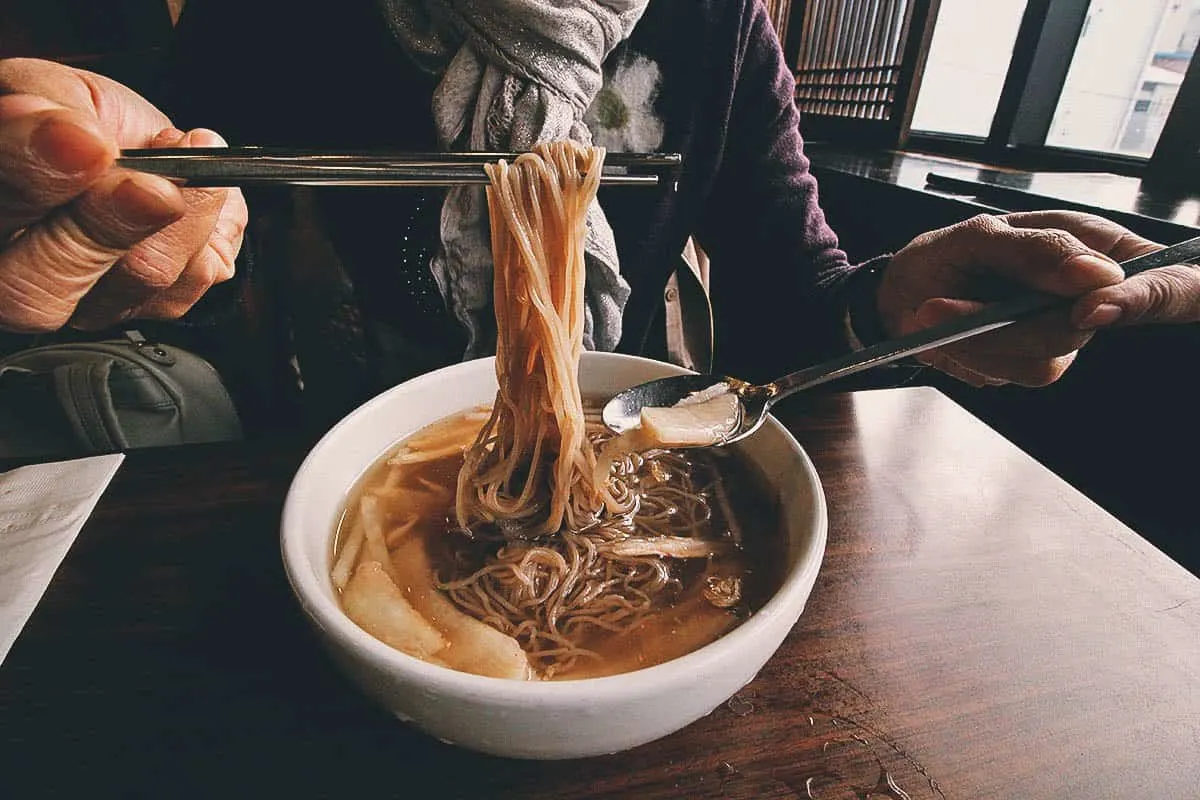
3. Myeongdong Kyoja
Myeongdong Kyoja is widely regarded as having the best kalguksu in the city. Kalguksu is a noodle dish consisting of handmade, knife-cut wheat flour noodles served in a large bowl with broth and other ingredients.
Myeongdong Kyoja has been in business for over 50 years and is located in the heart of Myeongdong. It’s a great place to have lunch or dinner when shopping in the area.
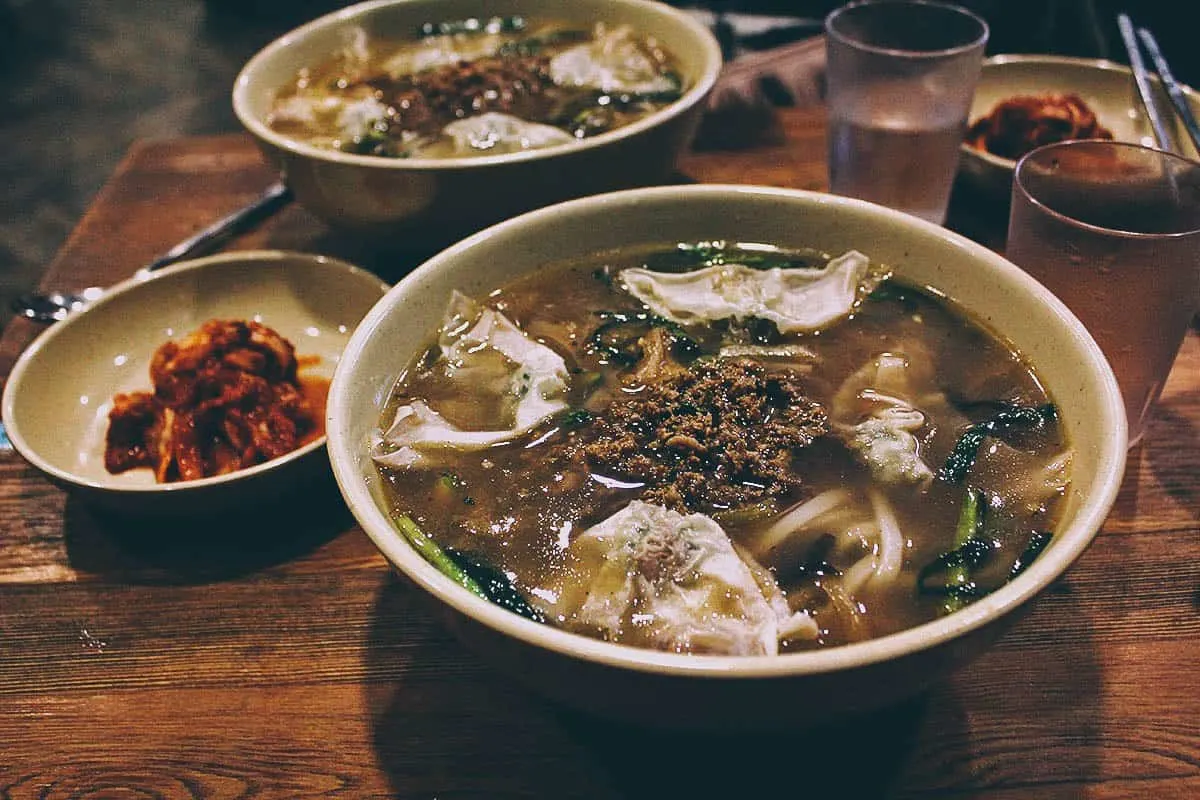
4. Manjok Ohyang Jokbal
I asked my Korean sister-in-law (who’s a former chef from Seoul) which dishes we should try, and jokbal was one of the things she recommended. Jokbal is a delicious dish of the most tender pig’s trotters cooked in soy sauce and spices.
I did a google search for “best jokbal in seoul” and Manjok Ohyang Jokbal was frequently cited. They’re a TripAdvisor Traveller’s Choice awardee with a stellar 4.5 star rating. Serious yum.
We bought a voucher for this medium portion of the spiced pig’s trotters bossam set menu from Klook. It’s good for 2-3 people and comes with jokbal, bossam (pork belly boiled in spices), dumpling soup, and a slew of sides.
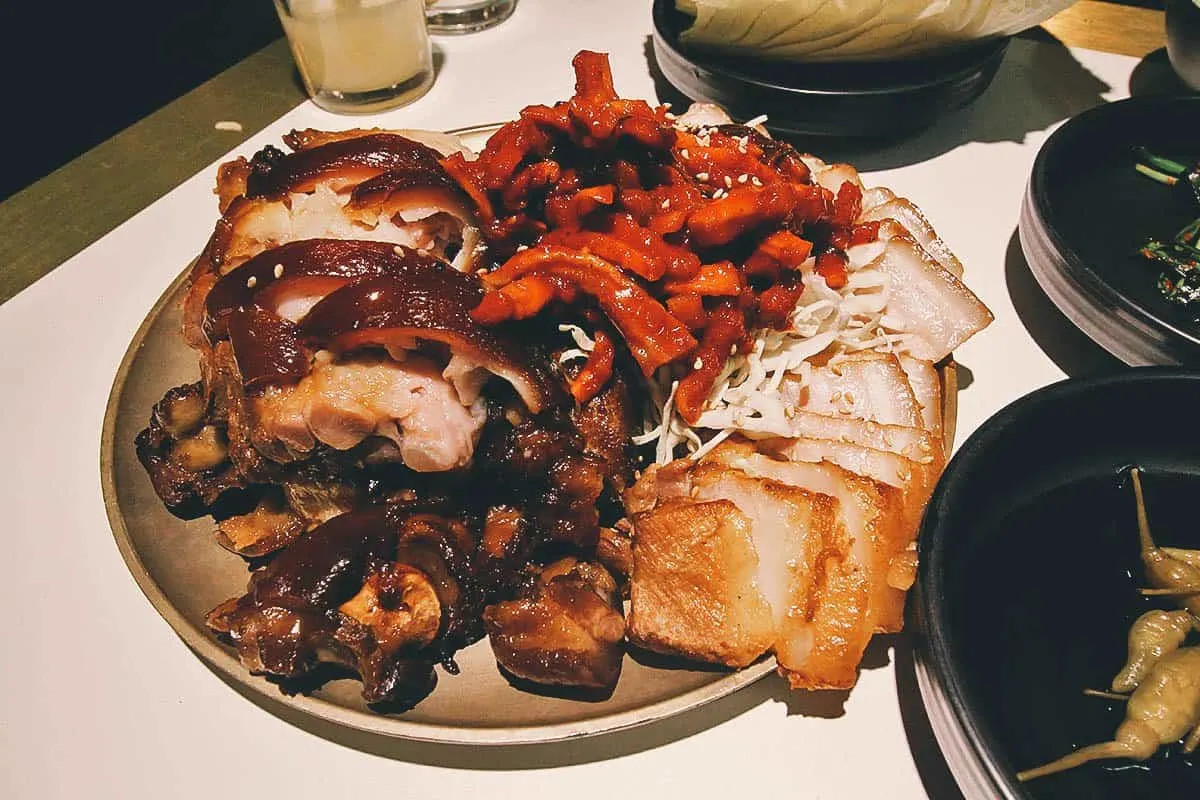
5. Wonjo Masan Halmae Agujjim
We skipped out on ganjang gejang on our first visit to Korea so I made sure to try it on our next trip.
Ganjang gejang is raw crab marinated in soy sauce. Considered by many to be the ultimate Korean dish, I waited over two years to try it and the experience blew me away. It’s so good and unlike anything we’ve ever tried.
If you like crab, then you have to try this dish. Like Korean bbq, ganjang gejang is expensive so expect to pay at least KRW 30,000 per small crab.
We had it at Wonjo Masan Halmae Agujjim. It’s one of several restaurants in Ganjang Gejang Alley that specializes in this interesting and supremely delicious crab dish.
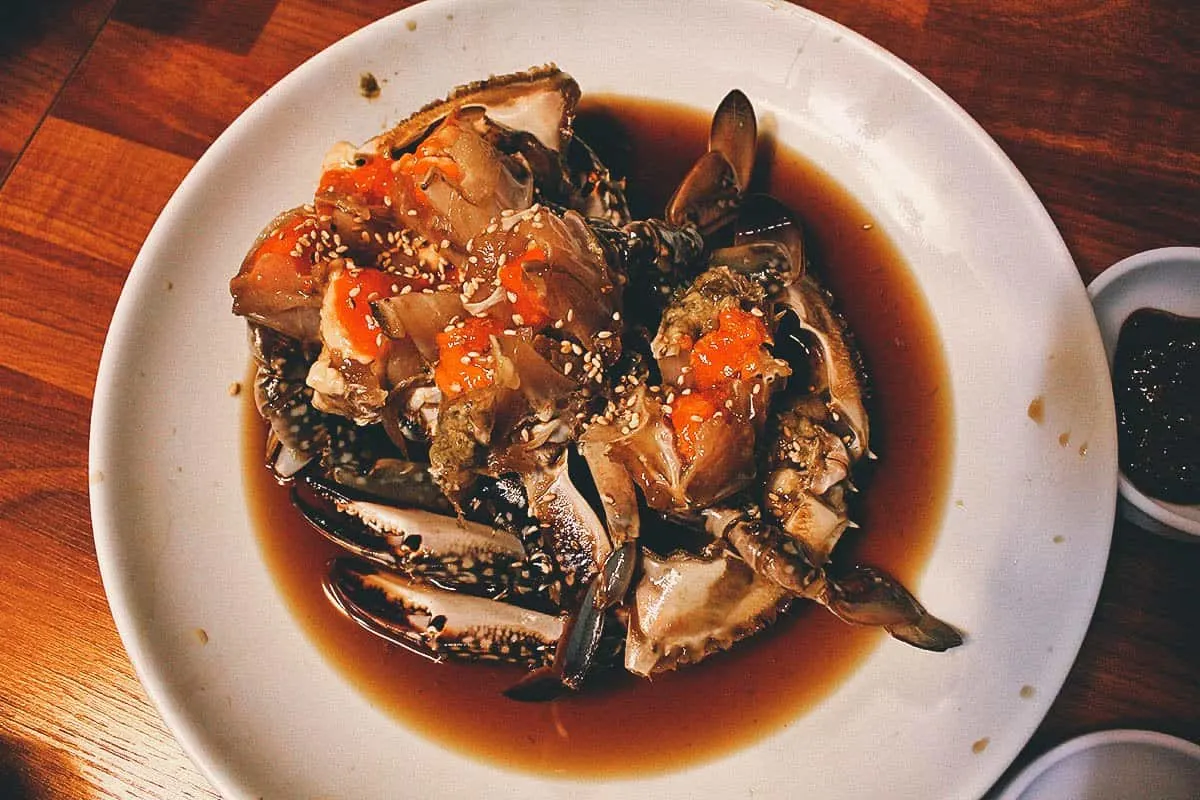
6. Myeongdong Food Street
As much as we love visiting restaurants, there’s something uniquely thrilling about eating street food. It’s like having a degustation experience right there on the street!
No first-time visitor’s trip to Seoul will be complete without eating street food in Myeongdong. With mouthwatering delicacies like grilled lobster tails, chicken and scallion skewers, and tteokbokki, Myeongdong is a Korean street food lover’s paradise.
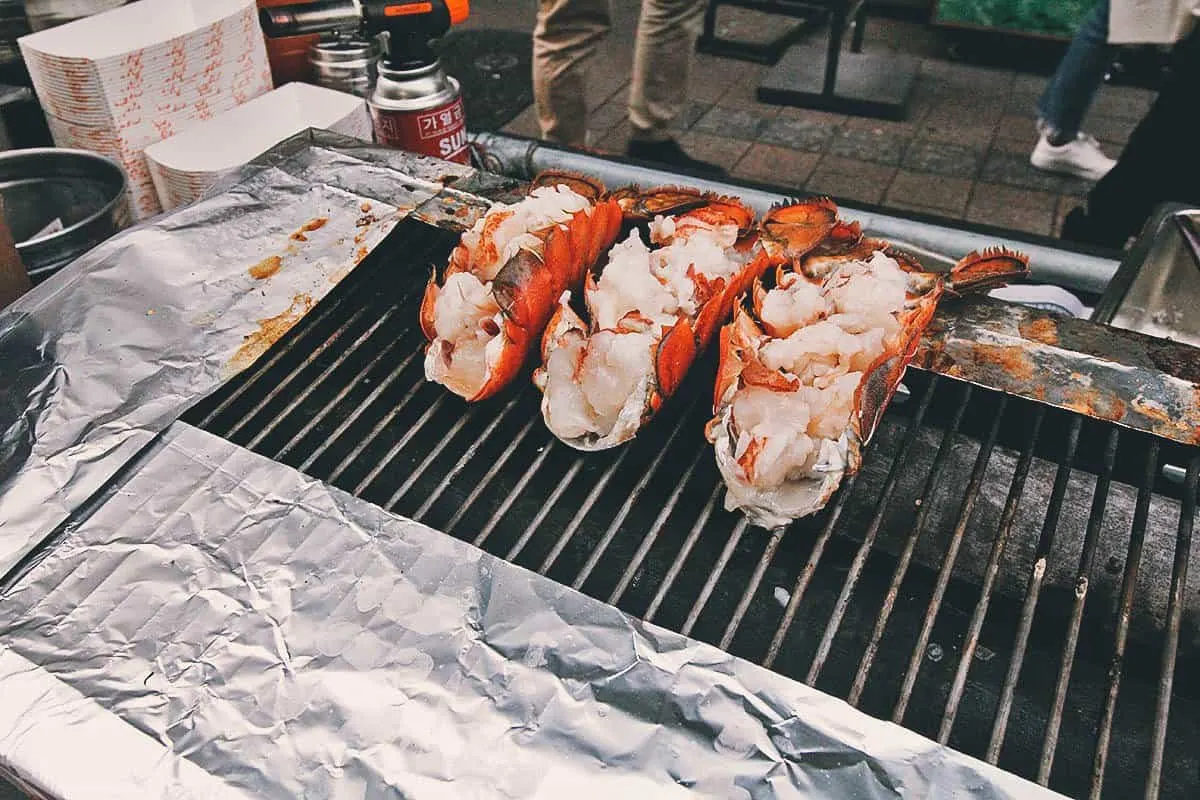
The restaurants above were some of our favorites, but if seven isn’t enough to satisfy your appetite, then you can check out our article on 25 must-eat restaurants in Seoul.
It includes plenty of other restaurant recommendations like where to find the best gomtang (beef bone soup), the most authentic Jeonju bibimbap, and cheap but delicious Korean BBQ. It’ll even tell you where to find Seoul’s oldest restaurant, a 110+ year old institution specializing in seolnongtang or ox bone soup.
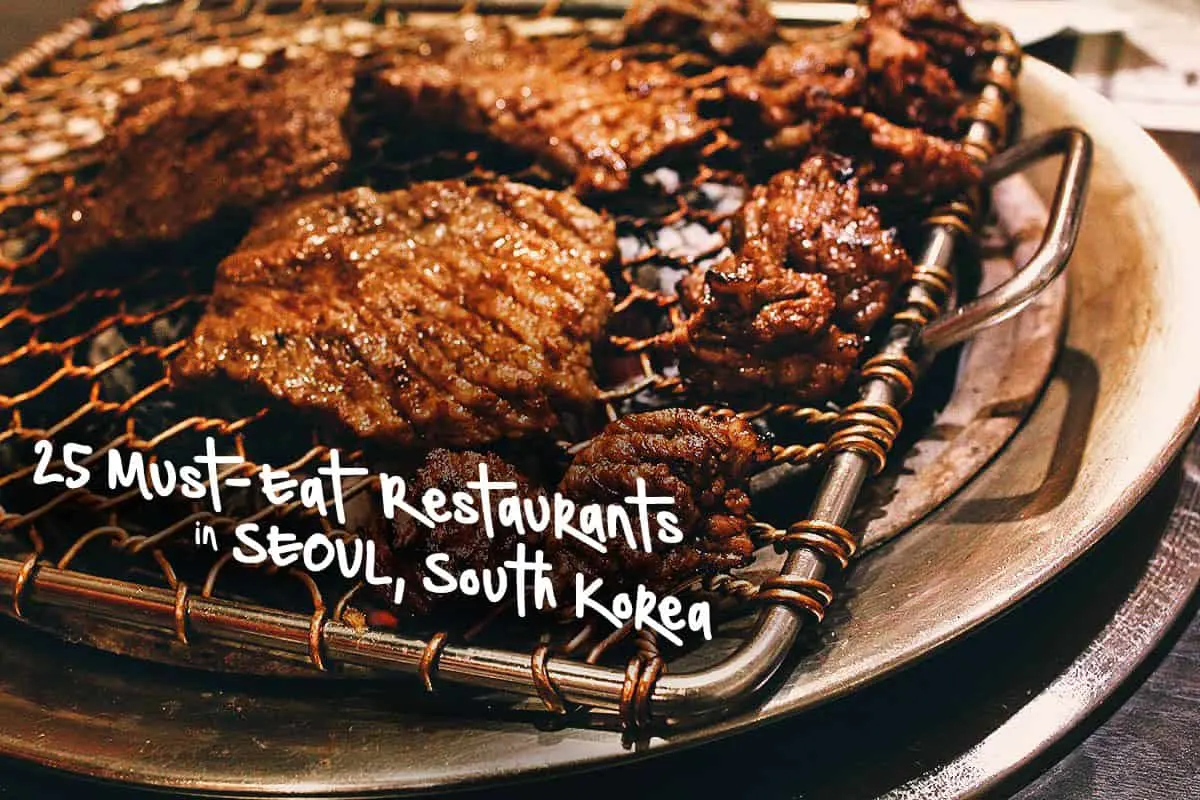
POINTS OF INTEREST IN SEOUL
For your convenience, I created a map so you get a better sense of where everything is. All the places recommended in this guide are pinned on this map. Click on the link to open a live version of the map in a new window.
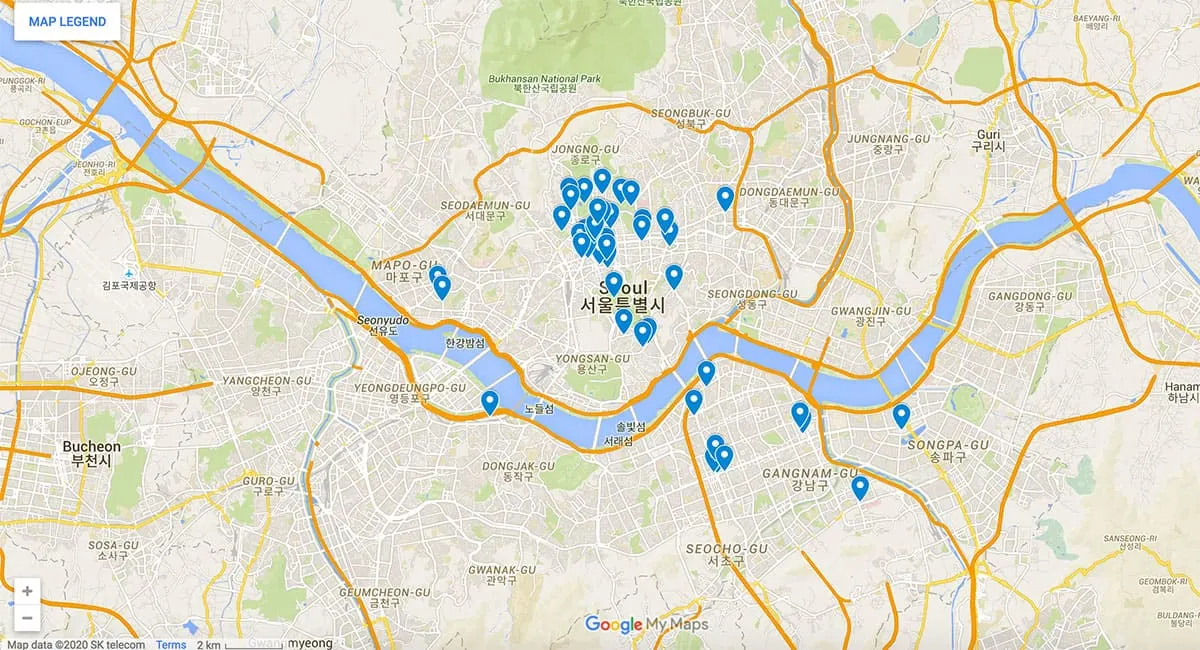
HOW TO GET AROUND IN SEOUL
Seoul’s subway system is very efficient, so much so that you probably won’t need any other form of transportation when you’re there. We never took a taxi and the only times we ever got on a bus was to go to places outside of Seoul like Paju, Suwon, and Jinhae.
It can be a little confusing at first but as long as you remember your destination’s subway stop and the line number that it’s on, then you shouldn’t have any problems.
You sometimes have to walk far to transfer between lines so it’s important to know the line number of your stop. Otherwise, you won’t know which way to go to transfer lines. Whenever I include directions in our Seoul travel guides, I always try to indicate Line and Exit numbers.
It’s a good idea to invest in a T-money card. It’s a transportation card that eliminates the hassle of buying single journey tokens, plus it saves you KRW 100 per journey. It can be used to transfer between subway lines, buses, or from subway to bus and vice versa (within a transfer time limit) at no extra charge.
The card itself costs KRW 2,500 and it can be purchased at most convenience stores and subway stations. You can top it up with any amount at recharge stations found at every subway stop. If there’s any amount left over at the end of your trip, then you can have it refunded at a convenience store or refund station (minus a KRW 500 service charge).
Another option is to get a Korea Tour Card which is a variation of the T-money card. It has the same benefits as the T-money card, plus it gives you small discounts at some tourist spots, shopping centers, restaurants, and theaters.
We usually navigate with Google Maps but it doesn’t work as well in Seoul. It has something to do with street names being changed recently (or something like that) so it’s best to navigate with the NAVER Map instead (iOS | Android).
HOW MANY DAYS TO STAY / SEOUL ITINERARY
Seoul is a massive city with much to see. We don’t like to rush so we stayed over a week on each of our three trips to Korea. I think staying a week in Seoul is great, but if you’re pressed for time, then 5 full days will be enough for most first-time visitors to the city.
Here’s a quick 5D/6N Seoul itinerary I put together to help you plan your trip. Be sure to click through to our full 5-day Seoul itinerary for more details.
| DAY ONE • Gyeongbokgung Palace • Bukchon Hanok Village • Changdeokgung Palace • Changgyeonggung Palace • Jongmyo Shrine • Ikseondong Hanok Village • Insadong • Jogyesa Temple |
| DAY TWO • Gyeonghuigung Palace • Deoksugung Palace • Namdaemun Market • N Seoul Tower • Myeongdong |
| DAY THREE • Noryangjin Fish Market • Hongdae • Bongeunsa Temple • COEX Mall • Gangnam Shopping Street |
| DAY FOUR • Cheonggyecheon Stream • Gwangjang Market • Ihwa Mural Village • Dongdaemun Design Plaza • Itaewon |
| DAY FIVE • Nami Island |
SEOUL TRAVEL TIPS
1. Plan your Trip with Sygic Travel
Some people may find trip planning a little tedious or daunting. This free trip planning can make it easier and more fun.
What Sygic Travel does is allow you to visualize everything on a map, so you can easily group places of interest by location and put them all together in an efficient itinerary. Check out my article on the Sygic Travel app for more information.
2. Rent a Pocket Wifi Device
A constant wifi connection is a necessity these days, especially when you’re away on a trip. You’ll need it to translate, do research, use ride-sharing apps, and find your favorite K-drama filming locations. We never go anywhere now without renting a pocket wifi device first.
You can stay connected in Seoul by renting a pocket wifi device or buying a sim card. We always rent pocket wifi devices but sim cards are perfectly fine too. They’re even cheaper.
Regardless of your preference, you can rent a pocket wifi device or buy a sim card through Klook. If you’re in Asia, then be sure to go through the list as it may be cheaper to pick it up from your origin country.
3. Get an Integrated Palace Ticket
If you want to visit as many palaces as you can in Seoul, then you should definitely get an integrated palace ticket. Entrance to four major palaces — Changdeokgung (including Huwon), Changgyeonggung, Deoksugung, Gyeongbokgung — plus Jongmyo Shrine will normally cost you a total of KRW 17,000 for adults. With the integrated palace ticket, you’ll have access to all five for just KRW 10,000.
4. Get a Discover Seoul Pass
If you plan on visiting most of the attractions recommended in this Seoul travel guide, then I highly recommend getting a Discover Seoul Pass. It’s a tourist card that gives foreign visitors free admission to many of Seoul’s top tourist attractions. If you get a Discover Seoul Pass, then you won’t need to get an integrated palace ticket since free admission to all five historical attractions are already included.
Aside from free admission to tourist attractions, the Discover Seoul Pass gives you T-money function and discounts to various shopping and entertainment facilities in Seoul. You can get a 24, 48, or 72 hour Discover Seoul Pass on Klook.
5. Check for Discount Passes
I love going through e-commerce sites to find travel deals. I’ve bought vouchers from several different websites but for Seoul, my favorites are Klook and Get Your Guide. They have the widest selection at the best prices.
If you’re looking for deals on tours, shows, theme parks, and airport transfers in Seoul, then be sure to check out Klook and Get Your Guide. Even if I don’t buy anything, I often find interesting activities that I may not think of myself so it’s always worth a look.
6. Get Travel Insurance
Whether or not to get travel insurance depends on where we’re going, how long we’re staying there, and most importantly, what we’ll be doing. If all we’re doing is visiting Hong Kong and feasting on street food for a few days, then we may not get it. But if we plan on doing more physical things, things that could get us hurt, then we’ll definitely get travel insurance.
We buy travel insurance from SafetyWing or Heymondo. They’re popular travel insurance providers used by many long-term travelers. Follow the links to get a free quote from SafetyWing or Heymondo. Get 5{0b5b04b8d3ad800b67772b3dcc20e35ebfd293e6e83c1a657928cfb52b561f97} off on Heymondo when you use our link.
7. Bring the Right Power Adapter
Electrical outlets in South Korea are round so plugs are typically Type C or Type F. Be sure to bring the right power adapters for your devices. Electrical voltage is 220/230V.
Have Fun!
By no means am I an expert on Seoul but I do hope that you find this guide helpful. I’m only sharing some of the things I’ve learned from our trips. If you have any questions, then please feel free to ask us in the comment section below. You’re welcome to join our Facebook Travel Group as well.
Thanks for stopping by and have fun in the land of K-pop and kimchi!
OUR GEAR
These are some of the things we brought with us to Seoul. If you’d like to see what other gear we bring with us on trips, then you’re welcome to have a look inside our backpack. (NOTE: The following links are Amazon and other affiliate links.)
Disclosure
This travel guide contains affiliate links, which means we’ll earn a small commission if you make a booking at no extra cost to you. We only recommend products and services that we use ourselves and firmly believe in. We really appreciate your support as this helps us make more of these free travel guides. Thank you!

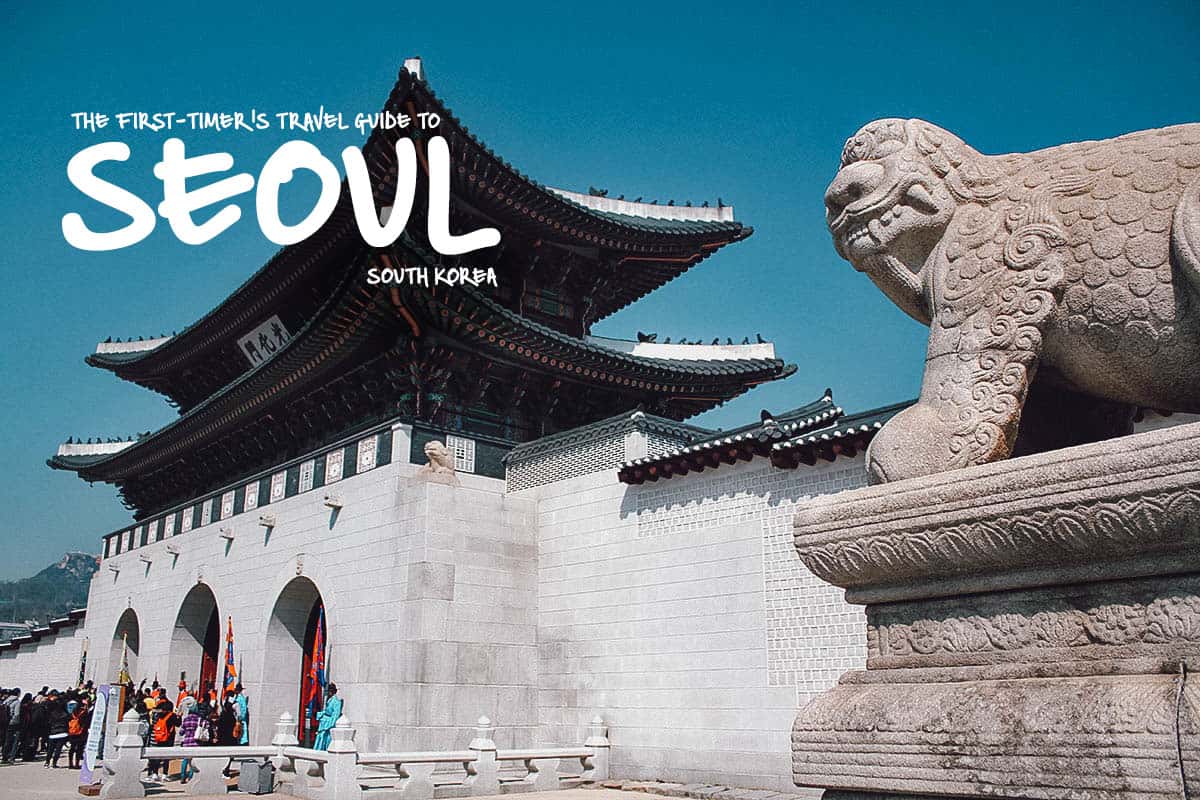
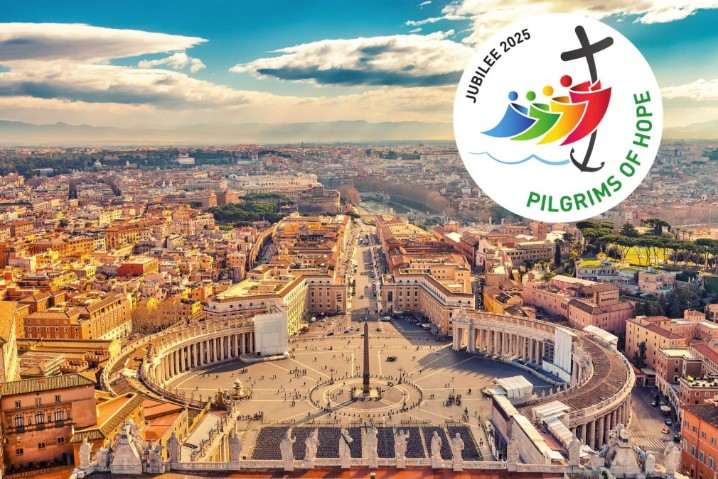
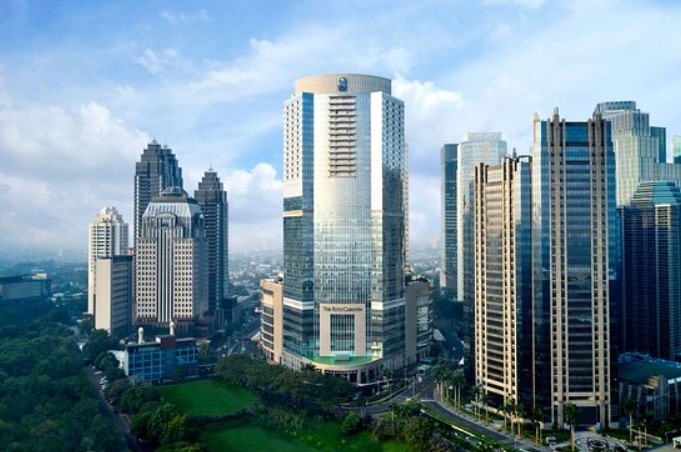

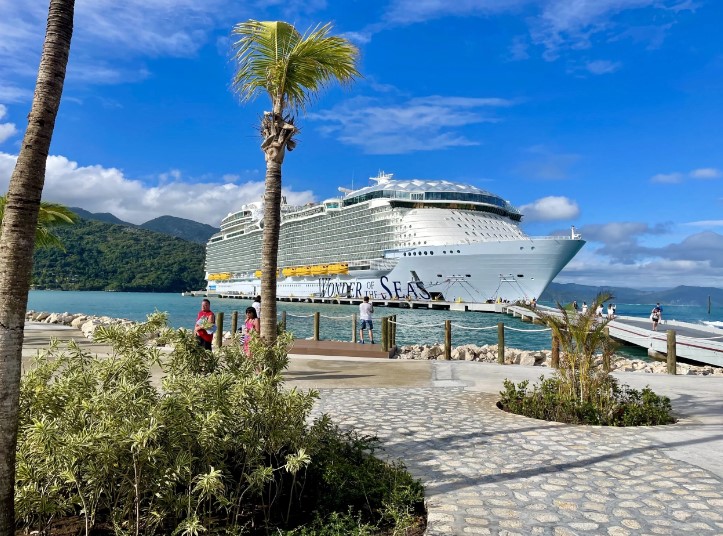
More Stories
This Phone Crossbody Is Perfect for Travel
Complete Guide To Croatia’s Medieval Seaside City
Universally Flattering Swimsuits I Always Pack